The Effect of Motion Pictures on the Social Attitudes of High School Children
Chapter 2
Ruth C. Peterson and L. L. Thurstone
Table of Contents | Next | Previous
Chapter II
The first of a series of experiments carried on in small towns was conducted in Genoa, Illinois, a town with a population of about 1200.[1] The experimental group consisted of 133 children of grades 7-12 inclusive. With the co-operation of Mr. Cloy S. Hobson, Principal of the Genoa Township High School, the following three schedules were given in the school on April 17, 1930.
(1) A scale of attitude toward Germans.
(2) A paired comparison of nationalities.
(3) A scale of attitude toward war.
On April 29 the motion picture "Four Sons" was shown at a special matinee performance in the local theatre. The three schedules were given again in the school the following morning, April 30.
The scale of attitude toward the Germans had the following directions and statements. The scale values, which are given here, were not, of course, given on the form presented to the students.
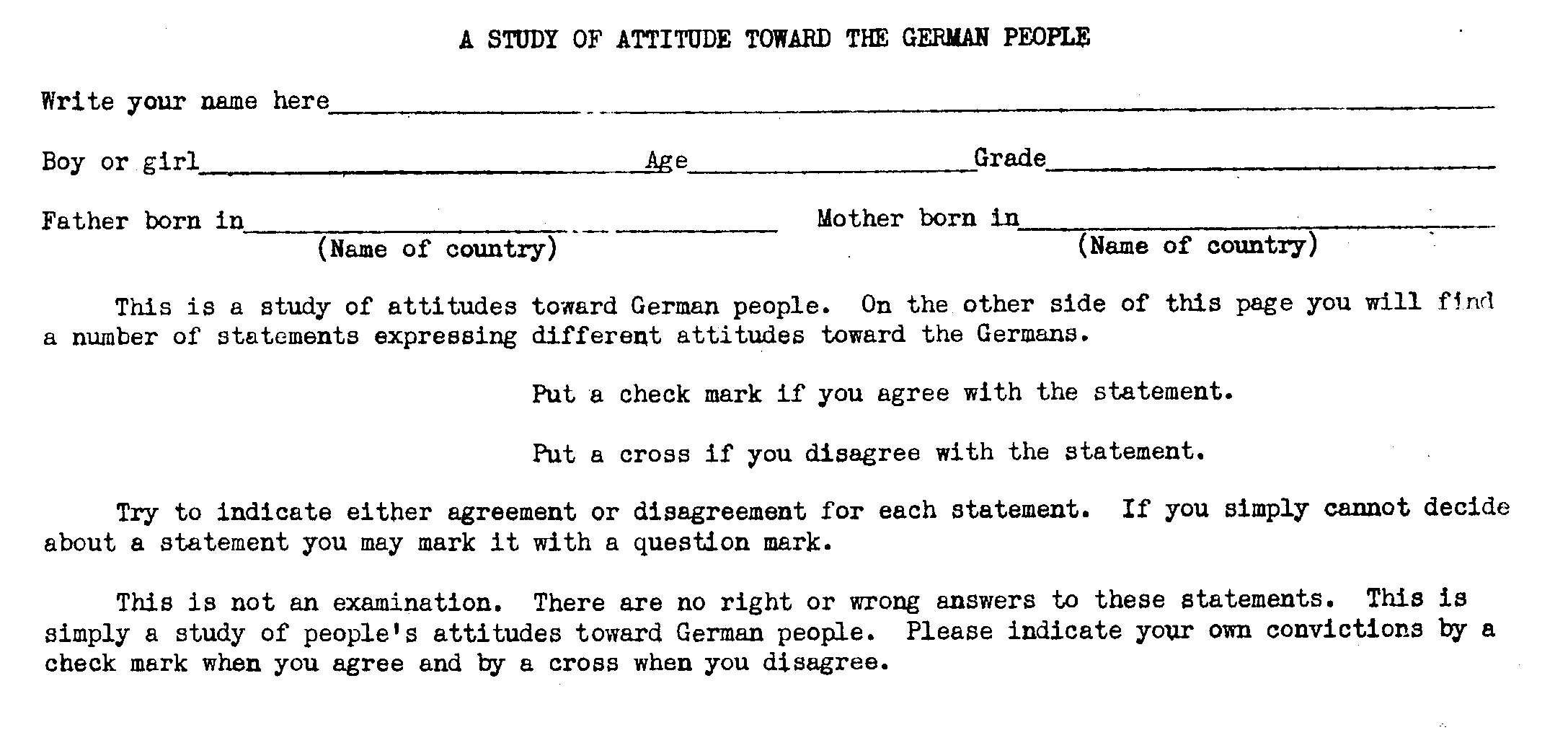
( 9)
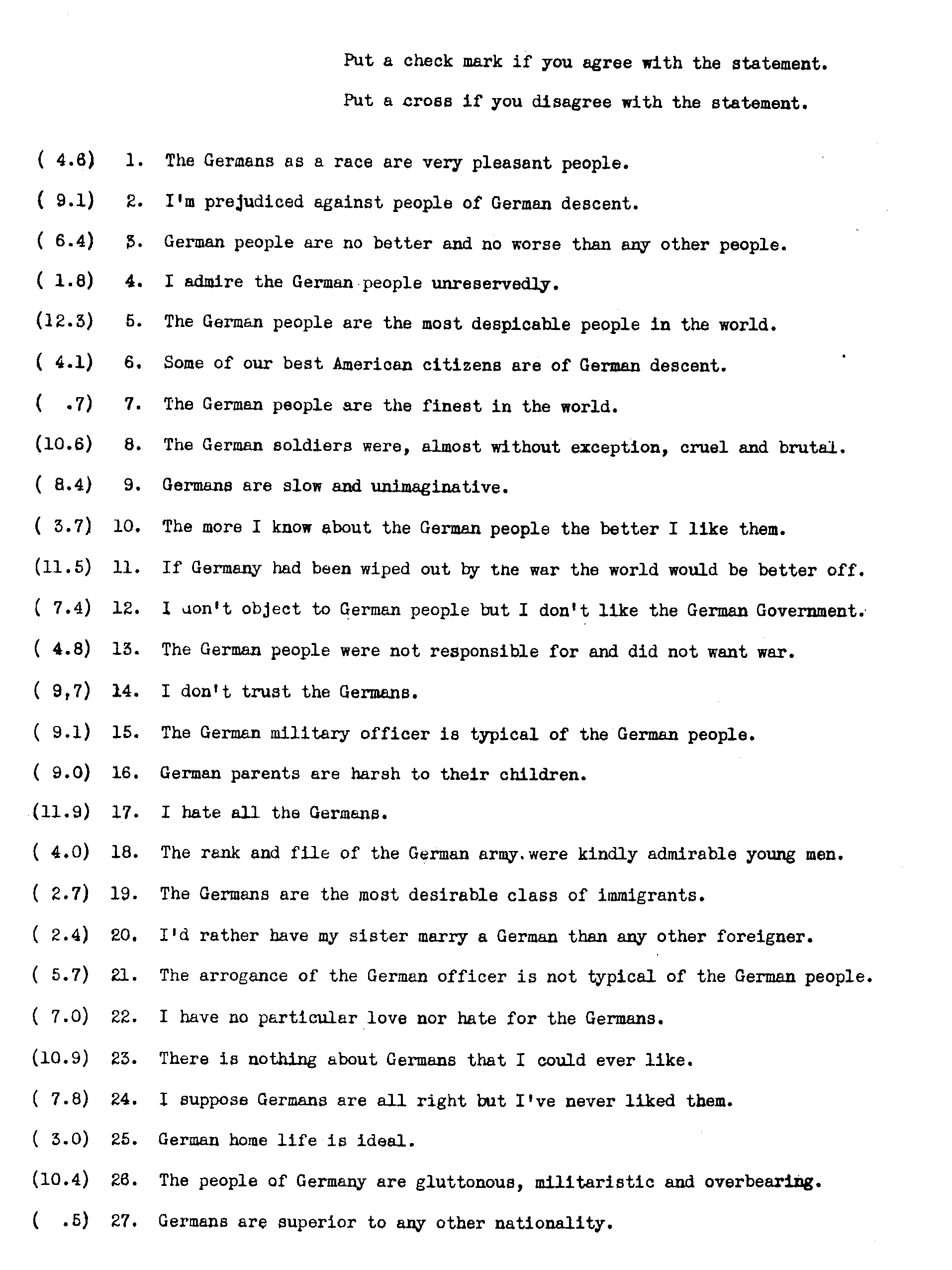
( 10)
Each individual's score was the median scale value of all the statements he indorsed.
Figure 1 presents two frequency distributions which show the effect of the film "Four Sons"' on the children's attitude toward Germans, as measured by the statement scale. The mean attitude of the group before seeing the film was 5.66; after seeing the picture it was 5.28, a difference of .38 οf a scale step representing a change in attitude favorable to the Germans. The P.E.D is .0708, and the ratio of the difference to the P.E.D is 5.37. The statistical facts about the two distributions are given below.
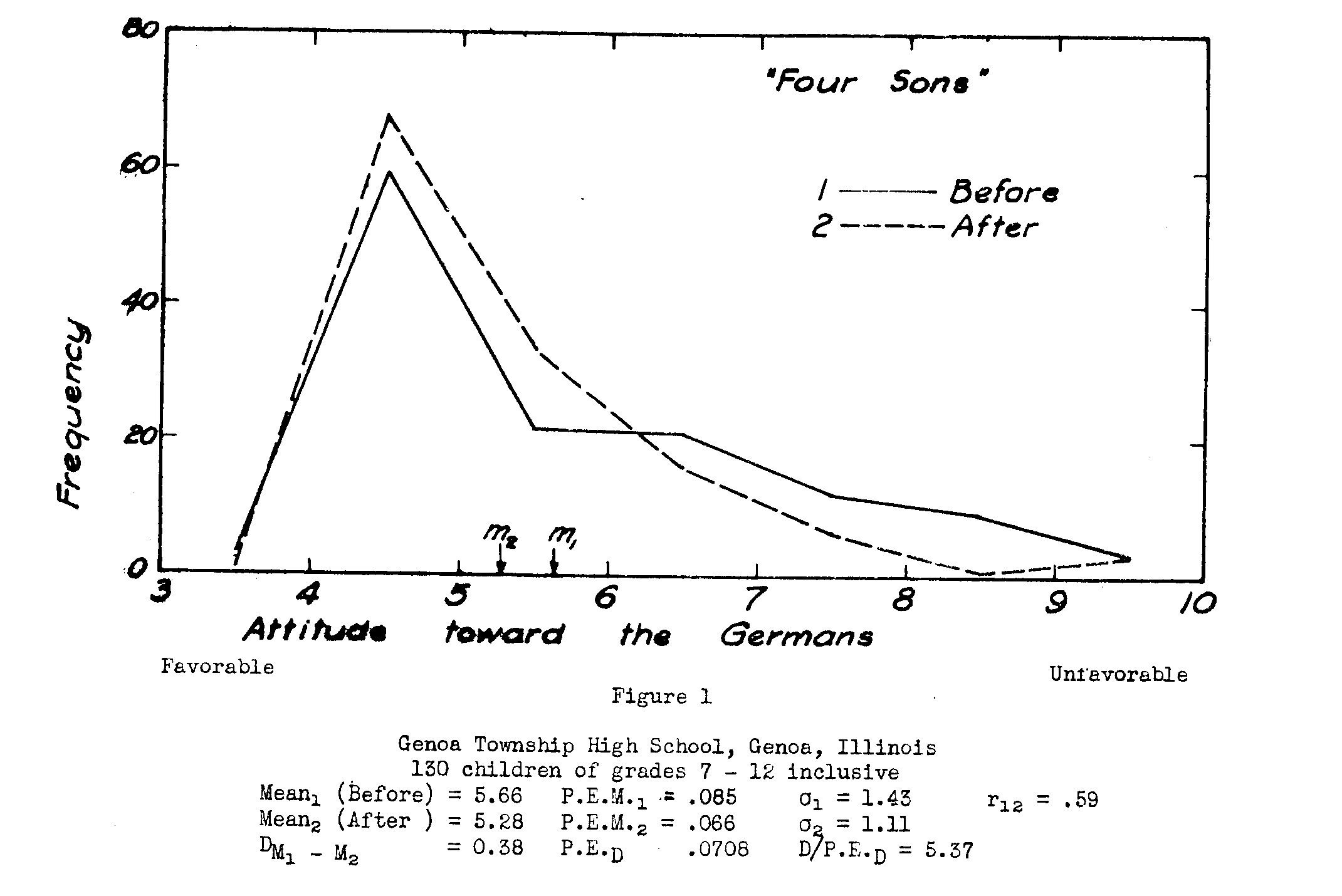
The conclusion that the film made the children definitely more favorable to the Germens seems to be justified.
( 11)
The paired comparison of nationalities had the following directions:
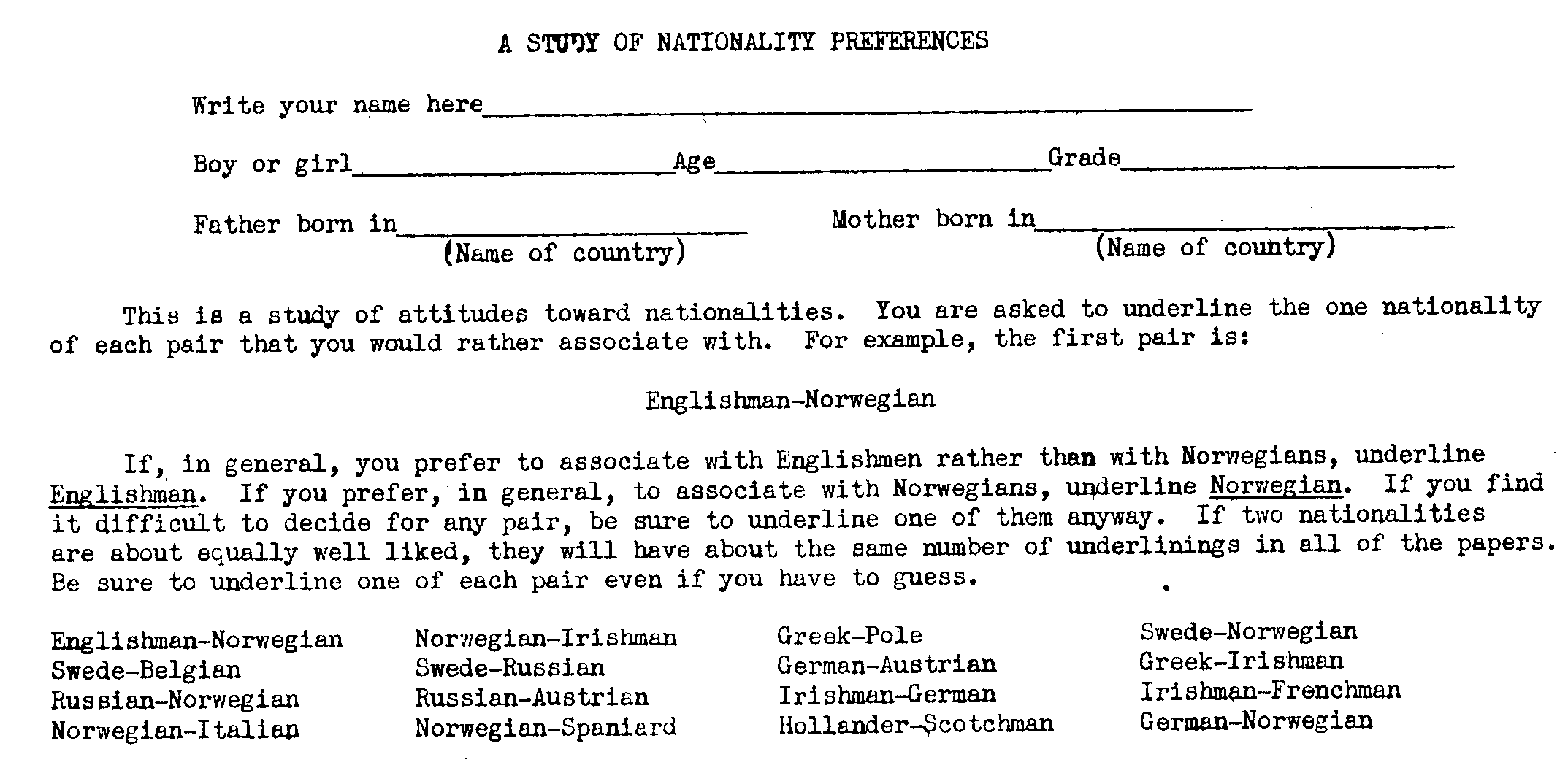
There were 15 nationalities in the list making a total of 105 comparisons of the type illustrated above.
Figure 2 shows the scale values, before and after seeing the film, for each of the nationalities which appeared in the paired comparison schedule. It is evident that the largest shift in scale value appears in the case of the Germans. It shows clearly that the film made the children more friendly toward the Germans. The shifts in scale value for the other nationalities are smaller , and most of them are of the order of magnitude which would be expected by the chance errors in the proportions from which the scale values were determined.
( 12)
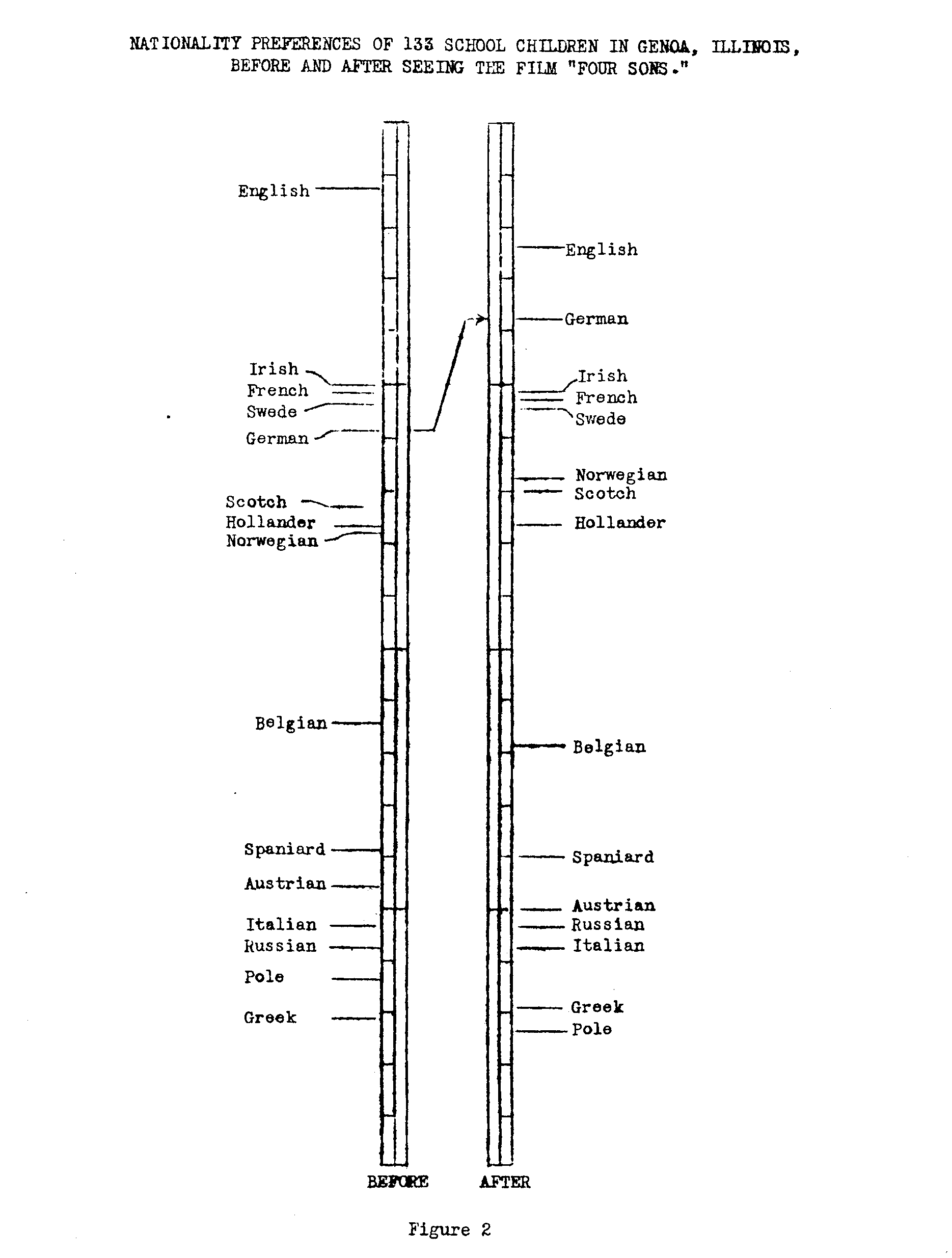
( 13)
The preferences before and after for each pair of which German was a member are tabulated below.
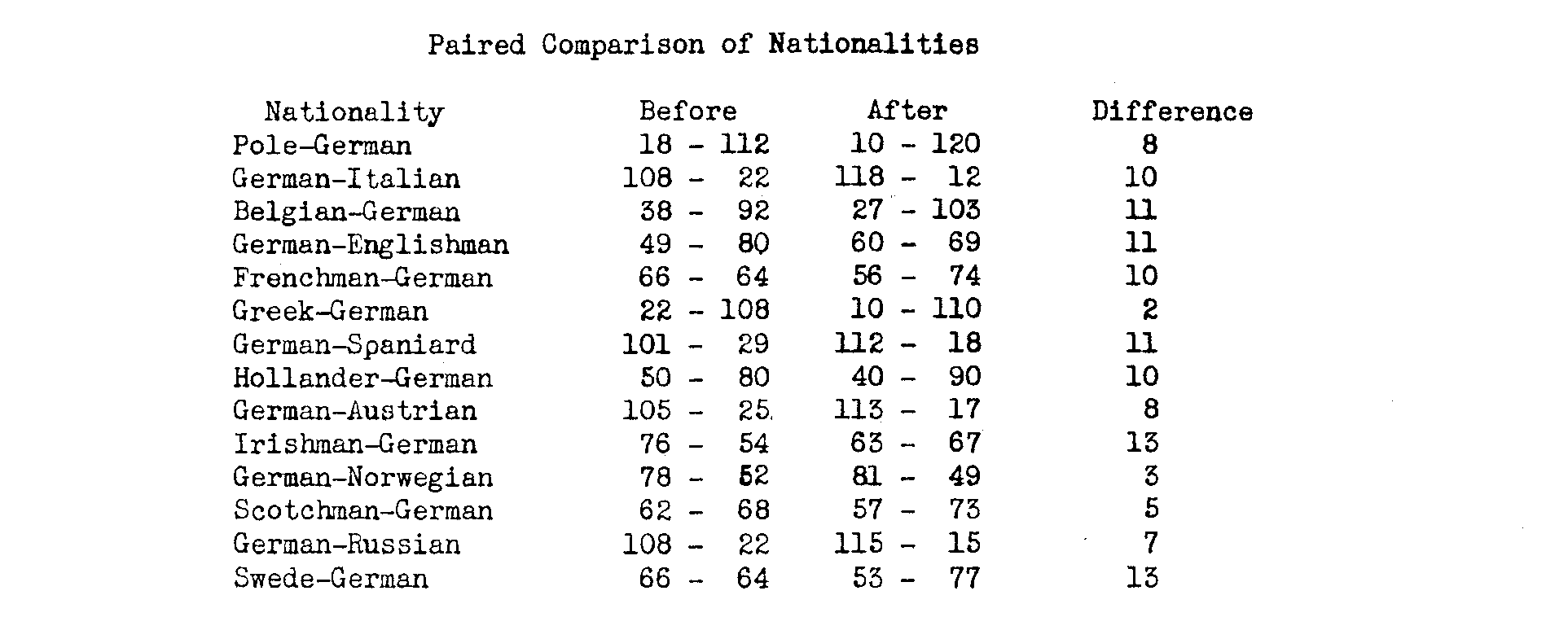
In every one of the above comparisons there was a change in attitude favorable to the Germans as a result of the film "Four Sons". The effect of the film on attitude is here very clearly shown. It is interesting to note that the Germans gained most (in number of shifts) at the expense of the Swedes and the Irish.
Attitude toward war was measured by the following scale. (The scale values did not appear on the form given to the students.)
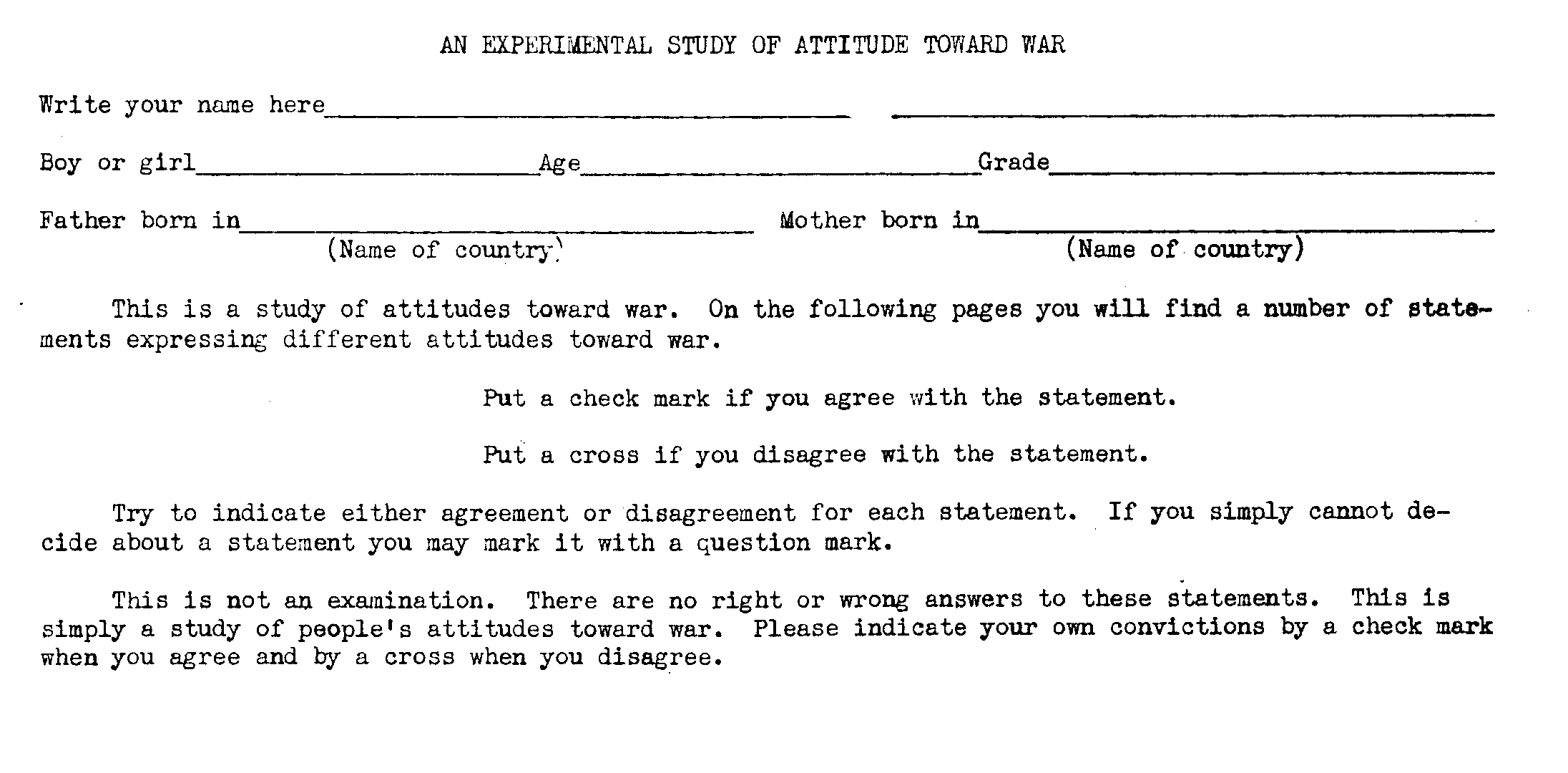
( 14)
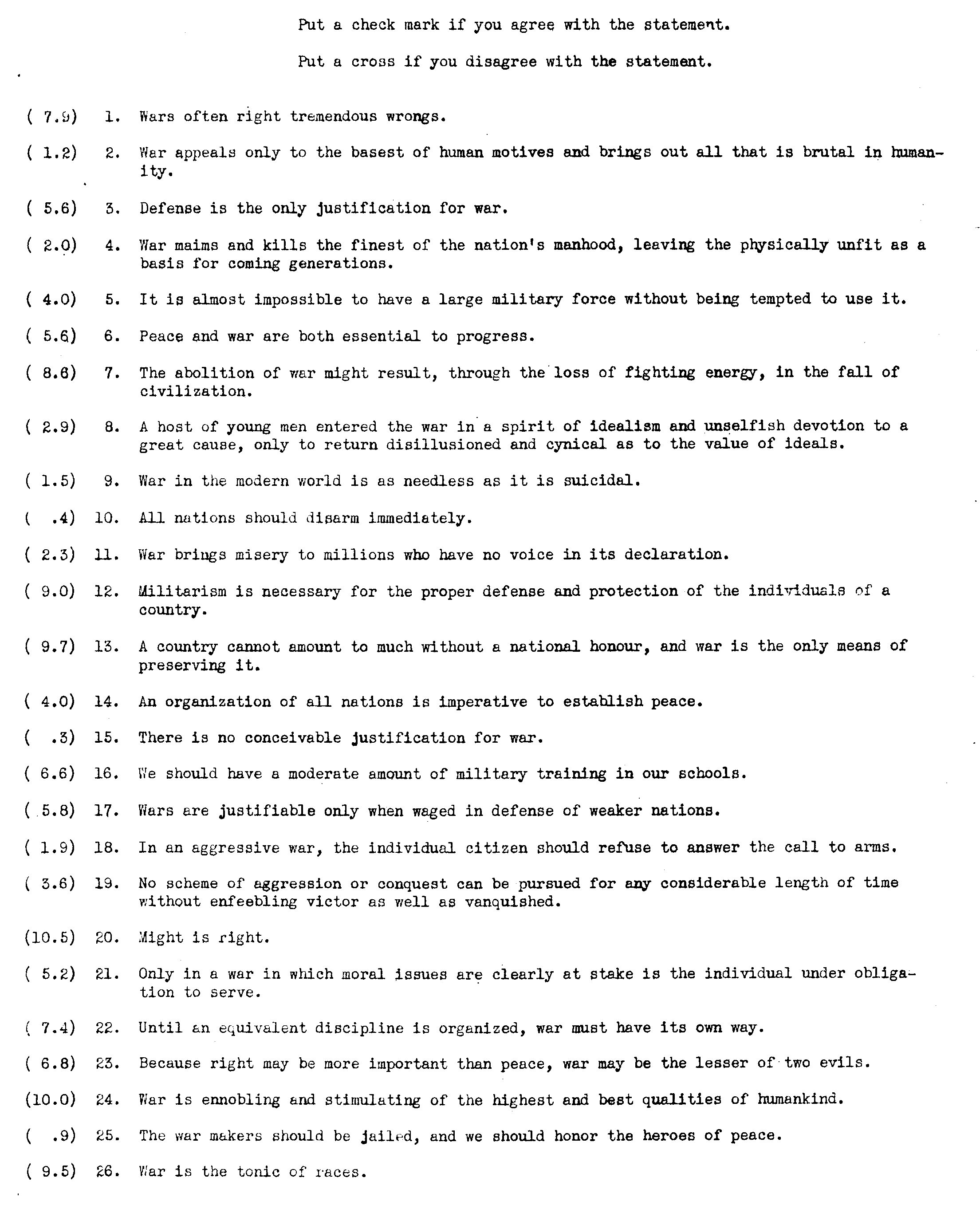
( 15)
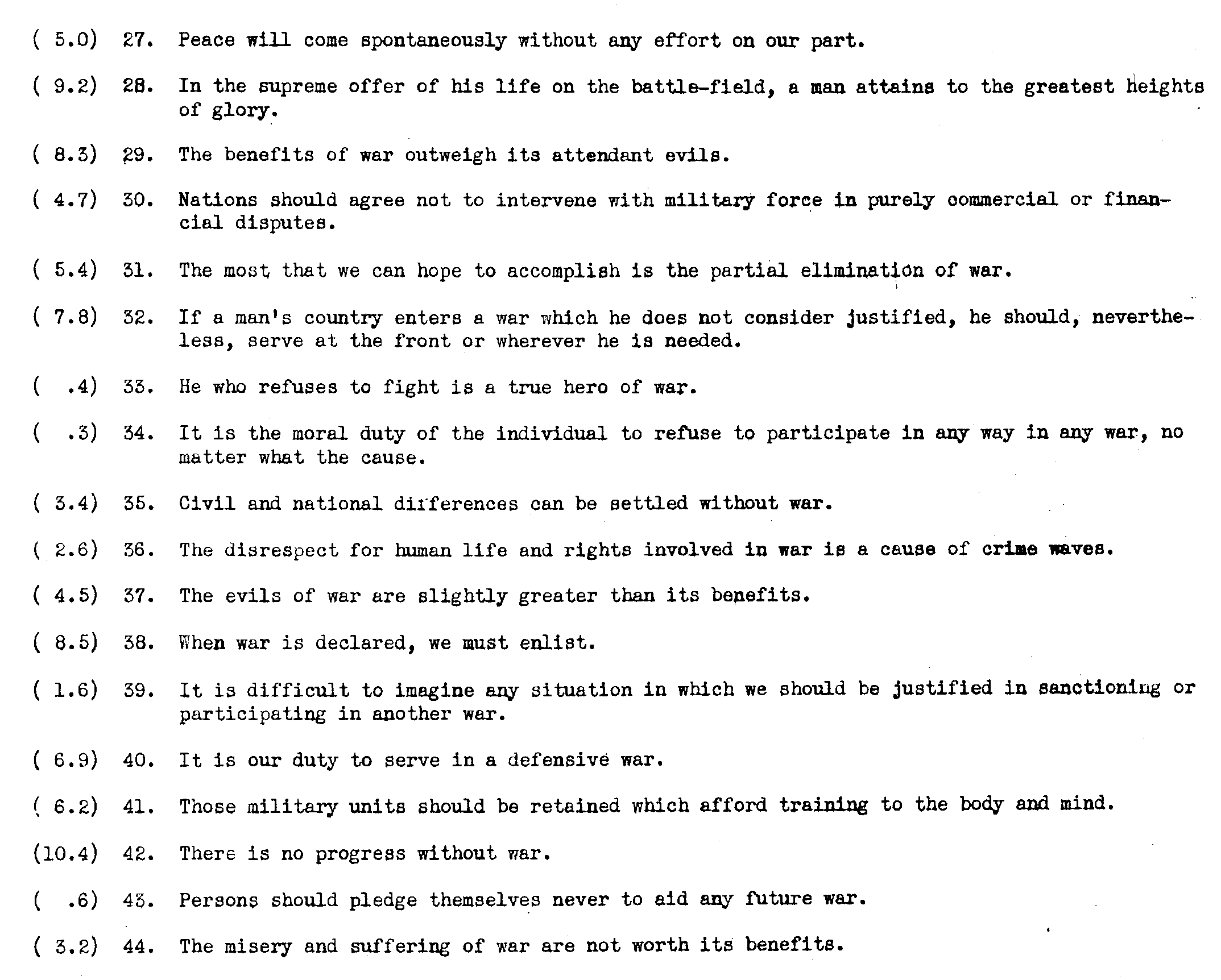
Figure 3 gives the distributions of attitude, toward war before end after seeing the film "Four Sons". The mean score of the group before was 5.19, after 5.10. The change is not large but it is in the expected direction.
( 16)
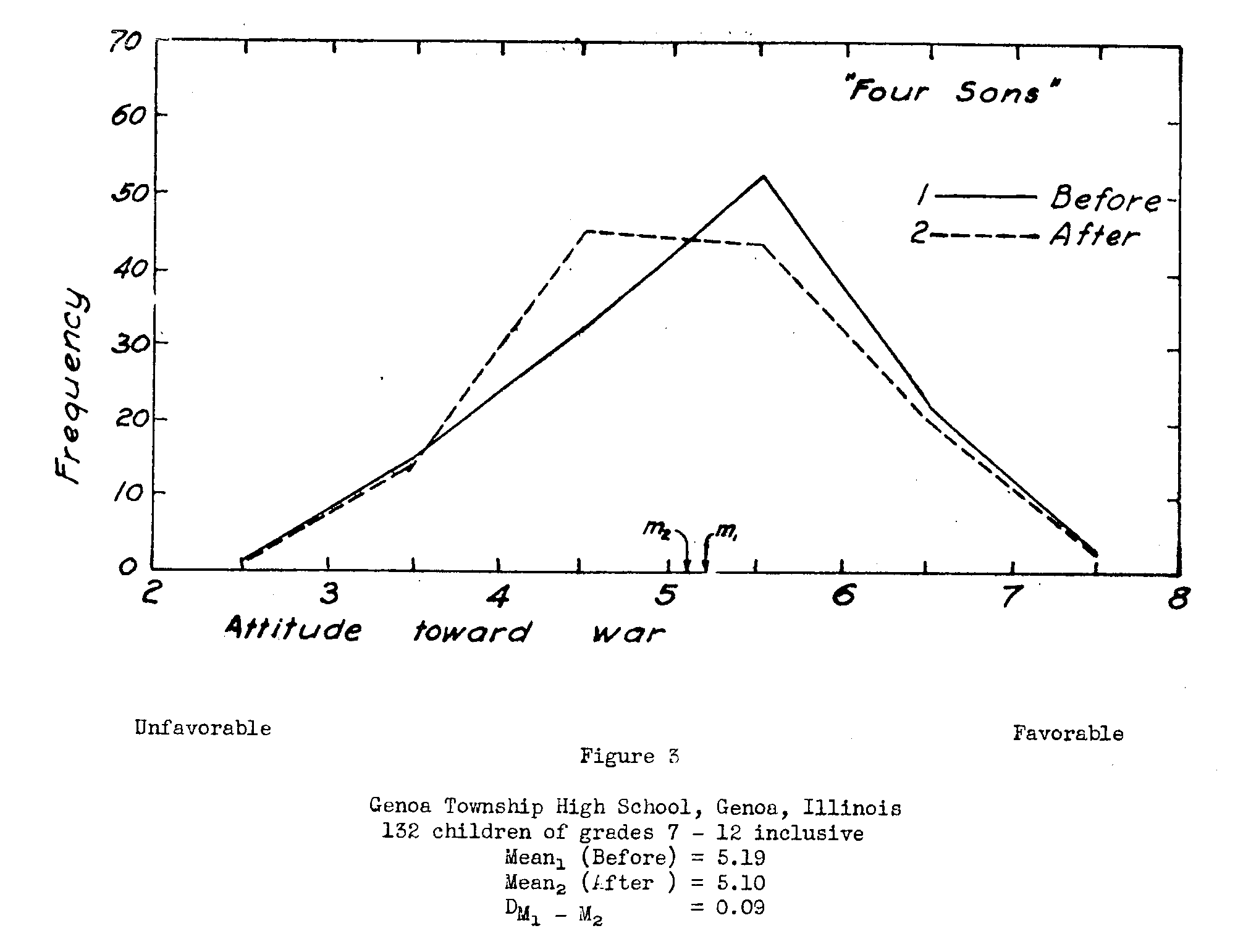
In conclusion we may say that the film "Four Sons" made the children more
favorable to the Germans and slightly less favorable to war.
An experiment wee conducted in Mendota, Illinois, a town of about 4000
population, to study the effect of the motion picture "Street of Chance" on the
children's attitudes toward gambling.[2]
The experimental group consisted of 240 children of grades 9 to 12 inclusive of
Mendota Township High School of which Mr. M. E. Steele is Principal. A paired
comparison of minor crimes was given in the school on May 15, 1930. The paired
comparison schedule had the following instructions:
( 17)
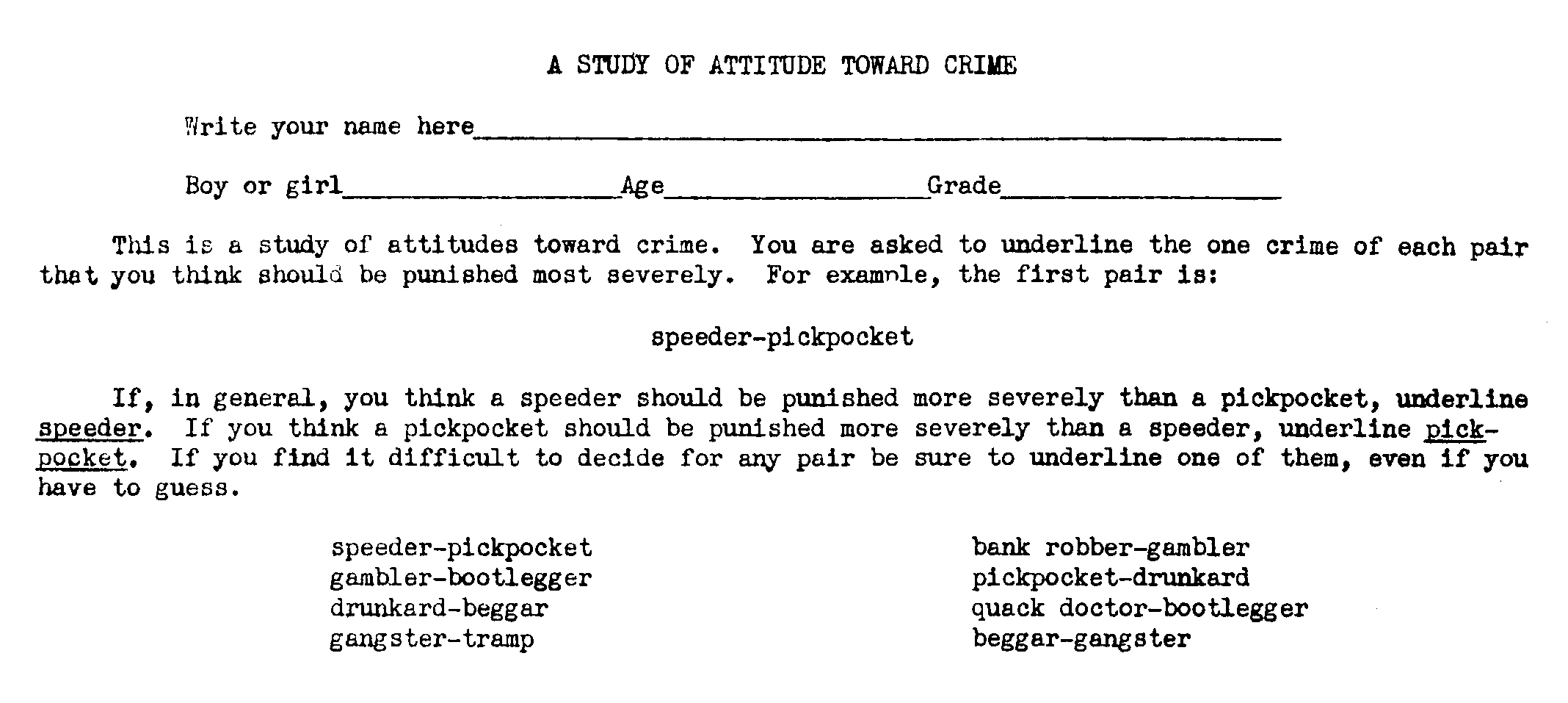
The schedule contained 78 comparisons of the type indicated. There were 13 crimes, and each crime was paired with every other.
On May 22 the film "Street of Chance" was shown at a special matinee performance in the local theatre. This film depicts the life of a gambler in such a way that t e children's attitudes toward gambling might be affected. The paired comparison schedule was given again in the school the following morning, May 23.
The scale values were calculated for each crime before and asters the children saw the film. Figure 4 presents the results graphically. It is evident that the scale values did not change markedly except for "gambler" which was regarded much more seriously after seeing the film than it was before.
( 18)
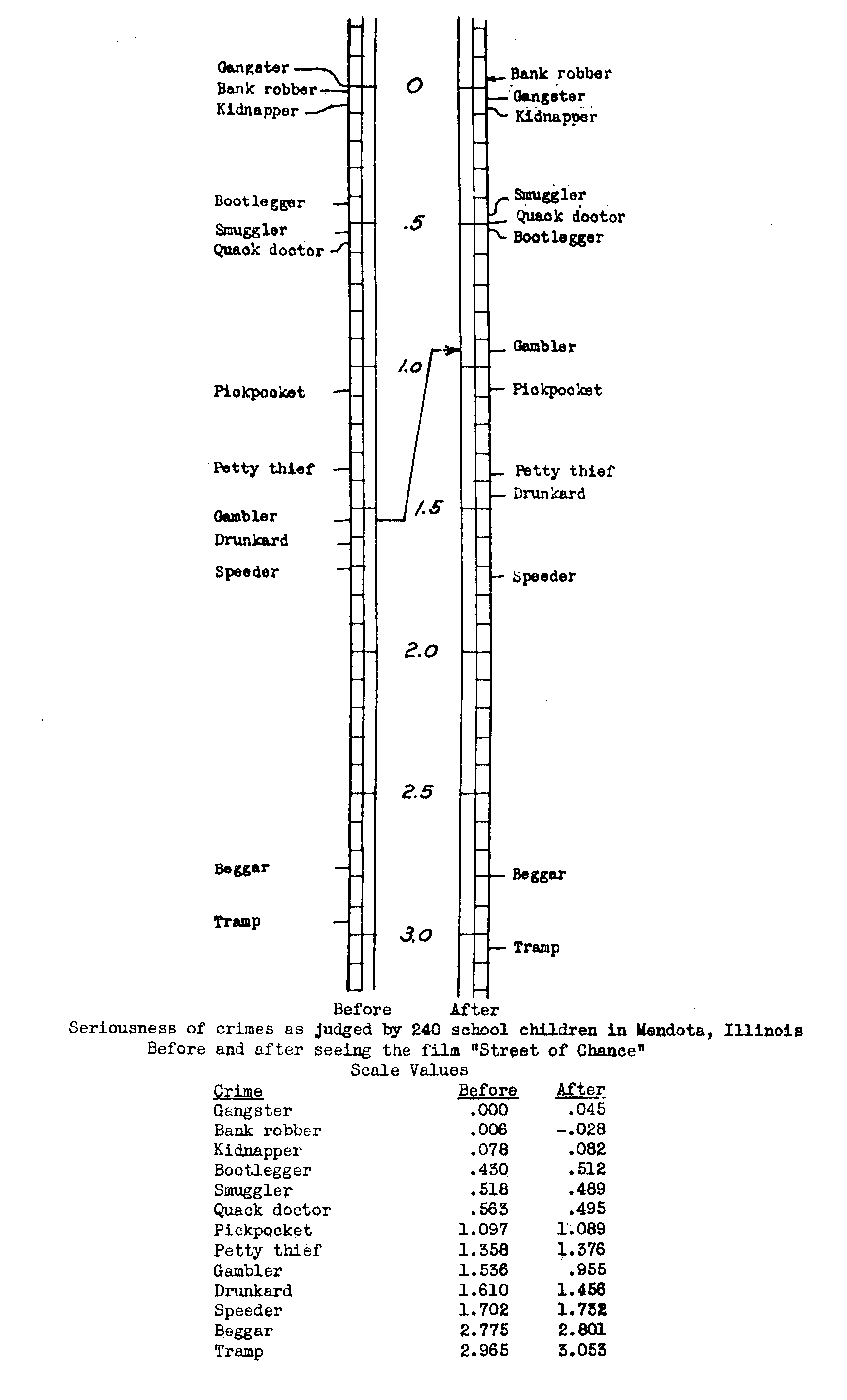
( 19)
The film "Street of Chance" may be said to have a socially approved effect, since it made the children more severe in their judgment of gambling even though the gambler was an interesting, likeable character in the film.
In Princeton, Illinois, a town of approximately 4,700 population, the experimental group consisted of 254 children of grades 9 to 12 inclusive.[3] Mr. 0. V. Shaffer, Principal of the Princeton Township High School, assisted us in the experiment. The same paired comparison of minor crimes that was given in Mendota and a scale of attitude toward prohibition were given in the Princeton High School on May 19, 1929. The scale of attitude toward prohibition contained the following directions and statements; (The scale values did not appear on the form given to the students.)
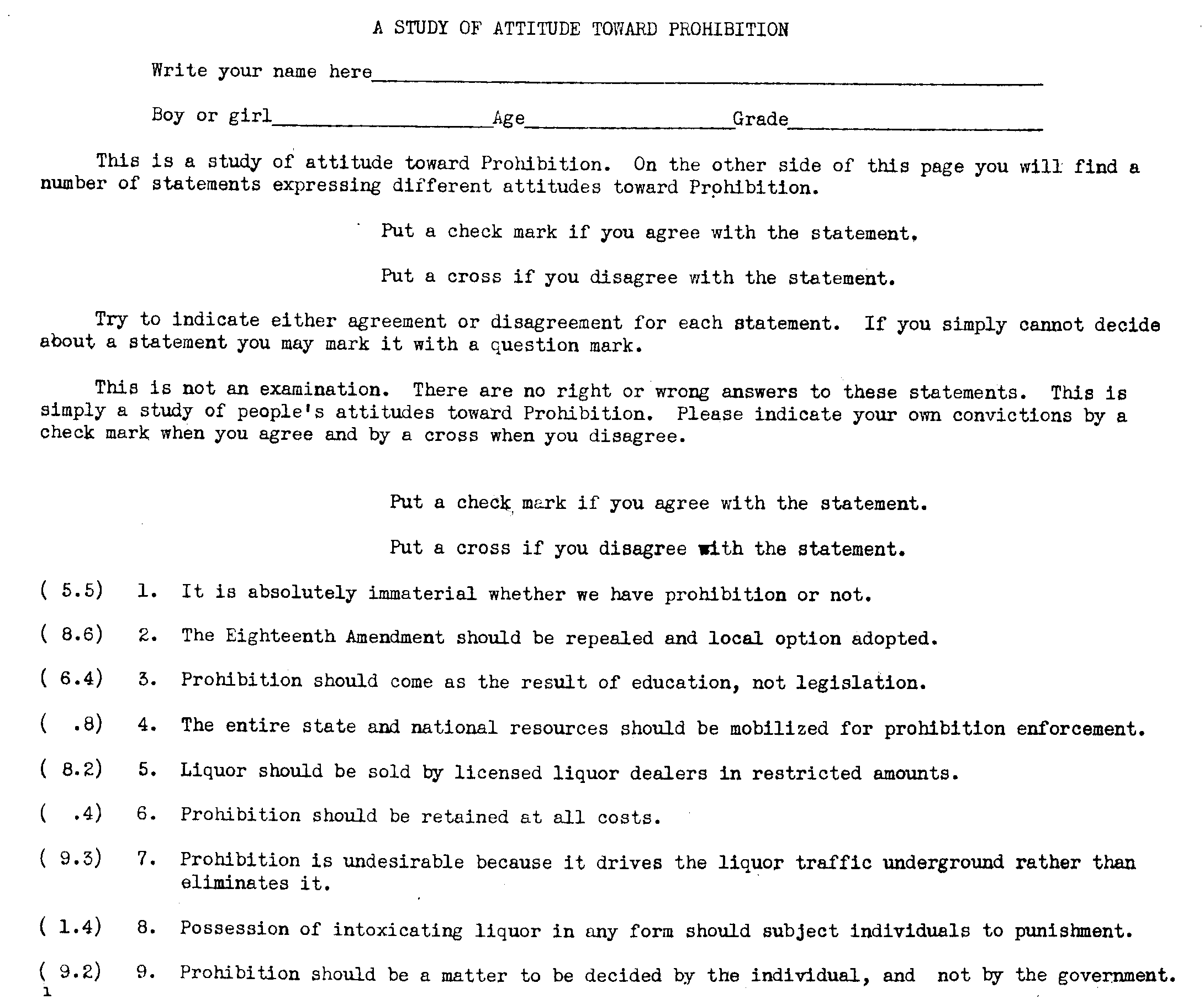
( 20)
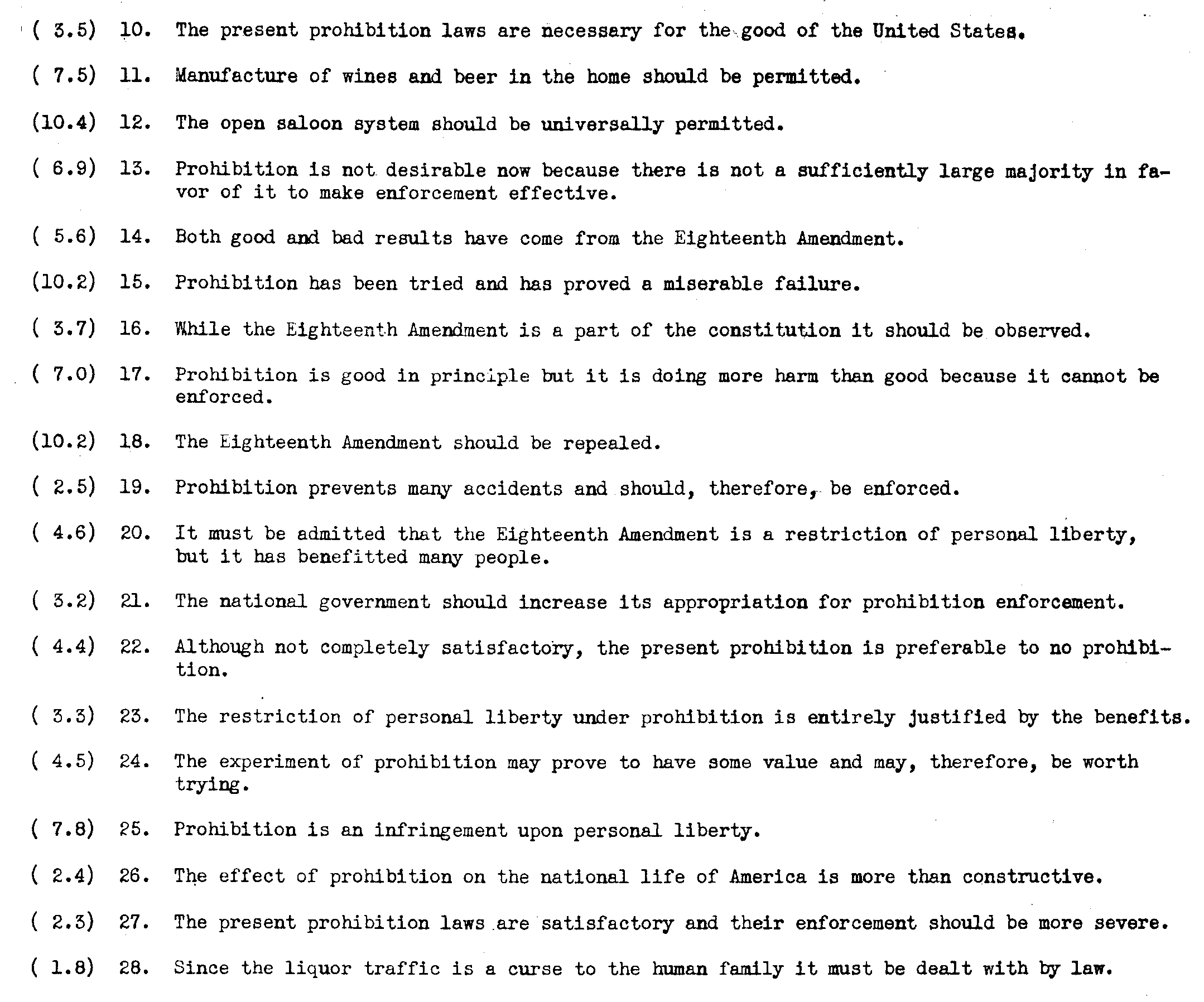
On May 26, 1929, the film "Hide Out", which portrays the experiences of a college bootlegger, was given at a special matinee performance in the local theatre. The experiment had been planned with another film which, it was found, had already been shown in Princeton. The film "Hide Out" had been criticized for its portrayal of a college bootlegger, and it was conceivable that it might effect the children's attitudes toward bootlegging and toward prohibition.
The frequency distributions of the attitudes of the group toward prohibition are shown in figure 5. The mean attitude score of the group before and after seeing the film shows no change.
( 21)
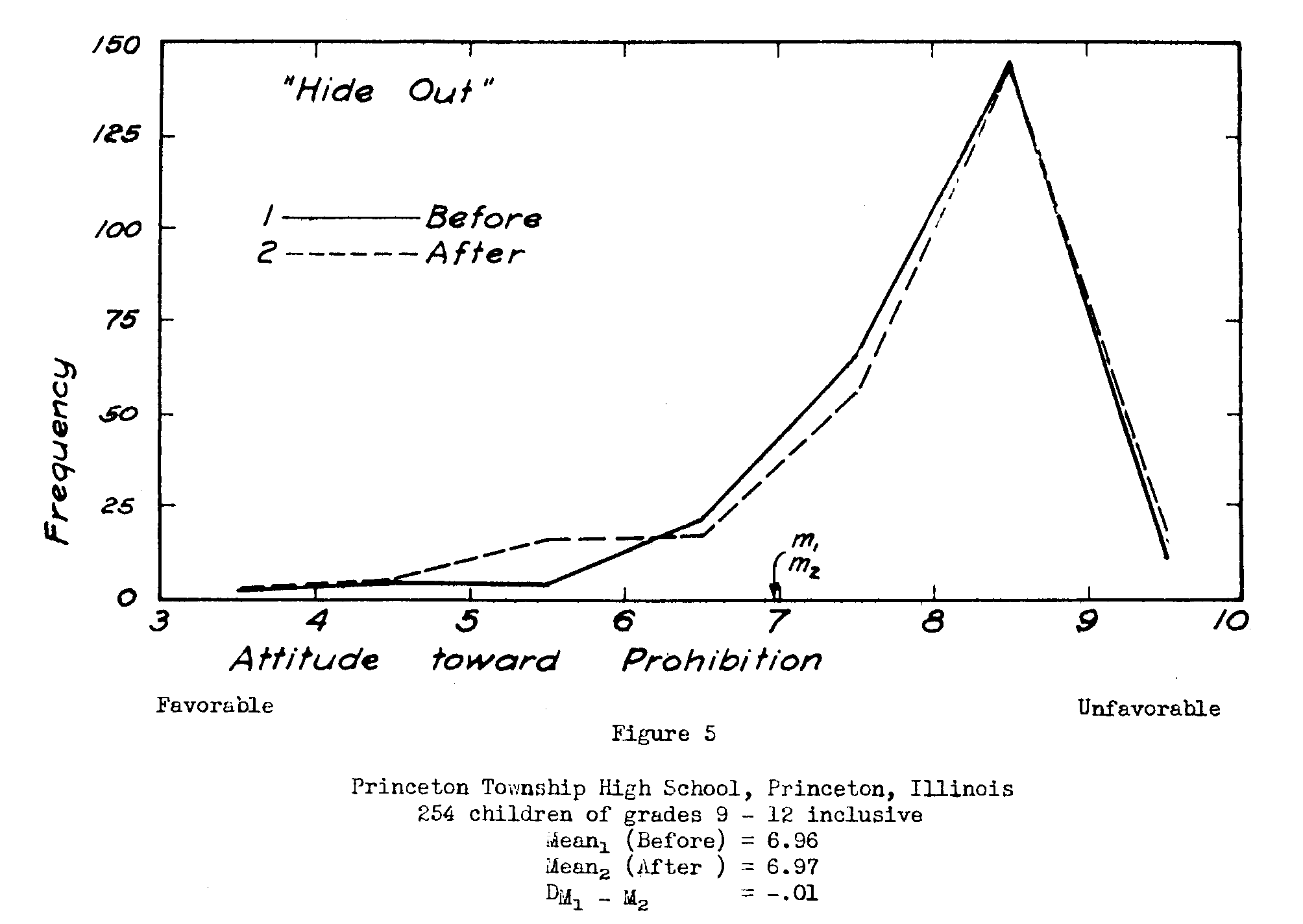
The paired comparison schedule shows only slight variations which are due to the chance fluctuations in the experimental proportions. We conclude that the film "Hide Cut" had no measurable effect on the children's attitudes toward prohibition or bootlegging.
The two following experiments were conducted in neighboring towns of comparable populations.[4]
The effect of a motion picture on the children's attitudes toward the Chinese was studied in each grοup, in one case with a film which has been considered friendly toward Chinese culture and in the second with a film which has been considered unfriendly and has, as such, teen criticized by the Chinese themselves.
In Geneva, Illinois, a town of about 4,600 population, the following scale of attitude toward the Chinese was given in the school on May 19, 1930 with the co-operation of Mr. H. M. Coultrap, Superintendent of Schools. (The scale values, which are given here, did not appear on the form used in the experiments.)
( 22)
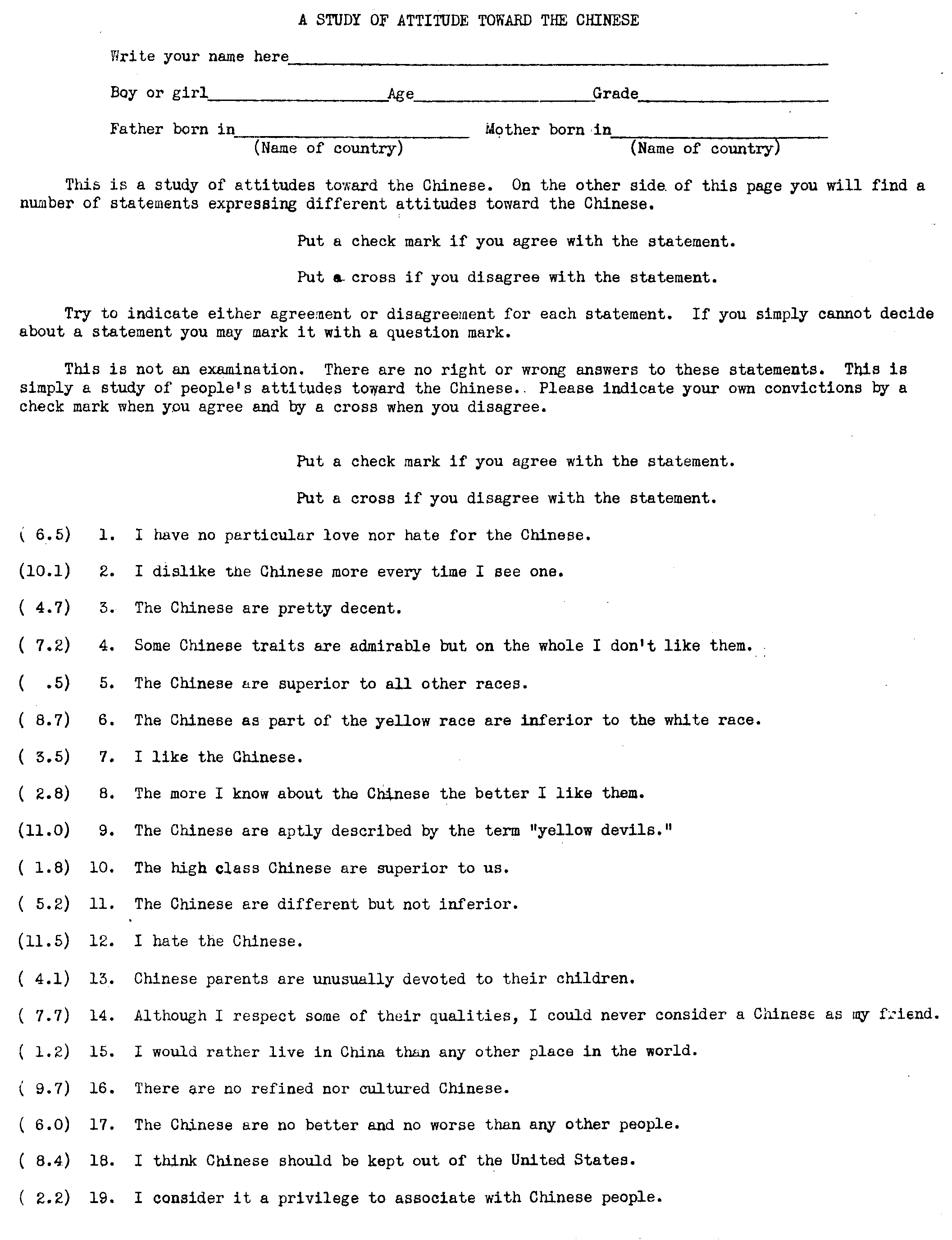
( 23)

The experimental group included 230 students of grades 9 to 12 inclusive. On May 26 tickets were distributed at the school which admitted the children to the regular evening performance of "Son of the Gods". "Son of the Gods" tells the story of Sam Lee who was brought up by an admirable Chinaman, Lee Ying, whom Sam Lee believed was his father. Sam Lee is an attractive, able person Whom people like and admire but who is not quite accepted because he is Chinese. The interpretation of Chinese life and culture ís friendly, and the Chinese characters are admirable people.
On the following morning the attitude scale was given again in the school.
Figure 6 shows the two distributions of attitude toward the Chinese before and after the children saw the film. The shift in attitude ís very striking. The statistical facts about the two distributions are given below the diagram.
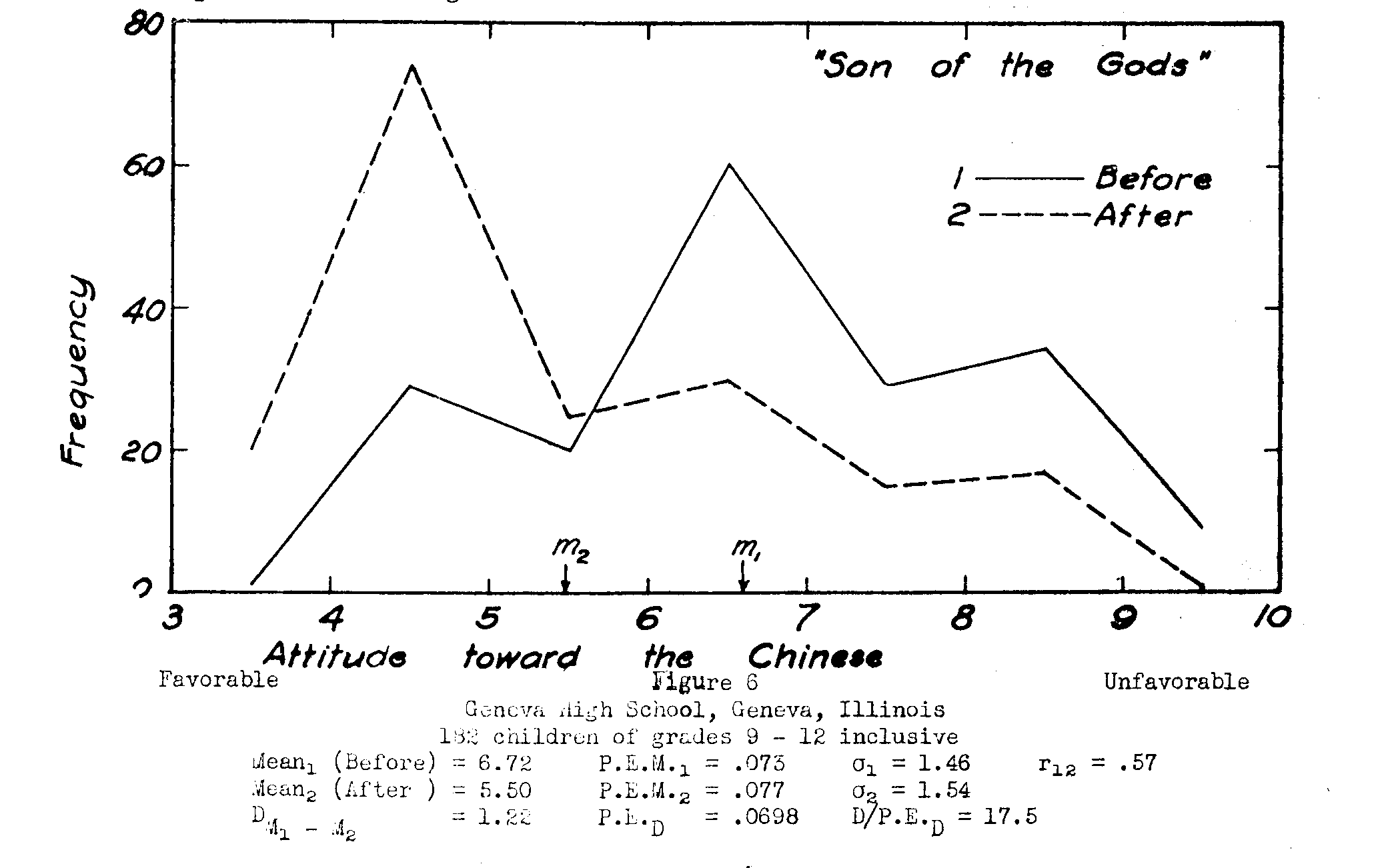
( 24)
The conclusion that the film "Son of the Gods" made the children more favorable toward the Chinese is undoubtedly justified.
In West Chicago, Illinois, which has a population of about 3,400, the same scale of attitude toward the Chinese was given on the same day, May 19, 1930. "Welcome Danger" is a film filled with Harold Lloyd comedy but picturing the Tong conspirators and the lawless element of underground Chinatown and has been criticized as unfriendly toward the Chinese. It was shown in the school auditorium on May 26 by permission of Mr. C. C. Byerly, Principal.
The attitude scale was repeated the morning of May 27. The experimental group included 225 children of grades 9 to 12 inclusive.
Figure 7 gives the two frequency distributions representing the attitudes of the group before and after seeing the motion picture. The mean score before was 5.71; after, 5.88, a change of .17 scale step, which is not large but is in the expected direction. The statistical facts about the two distributions appear below the diagram.
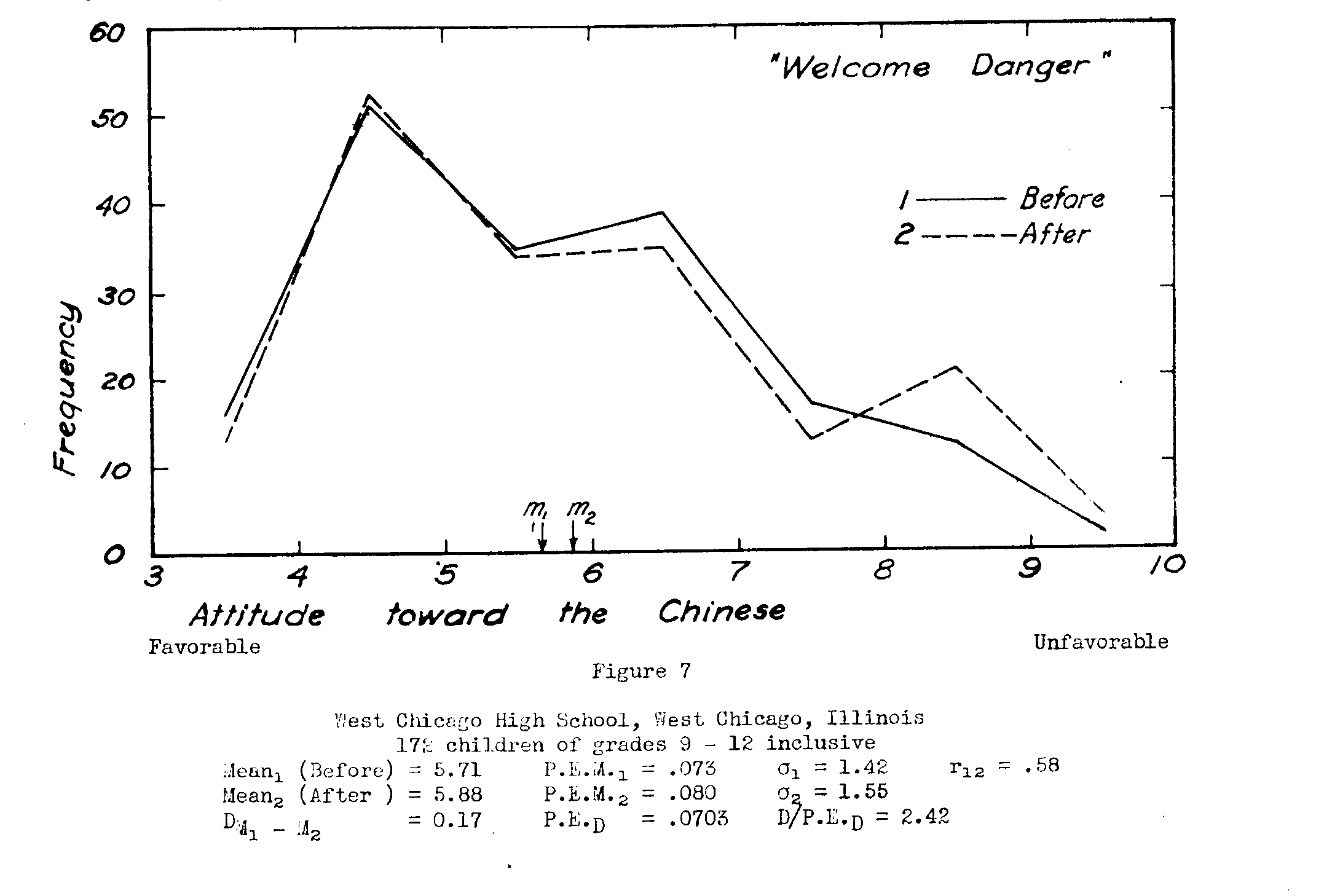
( 25)
An experiment was conducted at Genesee, Illinois, to study the effect of the motion picture "The Valiant" on the children's attitudes toward capital punishment. The experiment was made possible through the help of Mr. James D. Darnall, Principal of Geneseo Township High School. Geneseo is a town with a population of 3,400. The experimental group consisted of 501 children of, grades 4 to 12 inclusive. Α large age range was included because we were interested in studying the differences in the effect of a motion picture on different age groups.
The motion picture "The Valiant" was chosen for this experiment. It depicts the story of a young man who gives himself up to the police and confesses a murder. He is sentenced to die and keeps his identity a secret. His sister, whom he has not seen for many years, comes to see him. He tells her that he knew her brother who died on the field of battle. He sends her away without revealing himself as her brother and goes to his death.
The scale of attitude toward capital punishment was given in the school on January 21, 1931. "The Valiant" was shown in the local theatre on February 4, and the attitude scale was given again the morning of February 5.
The scale of attitude toward capital punishment contained the following instructions and statements. The scale values were not given on the experimental scale.
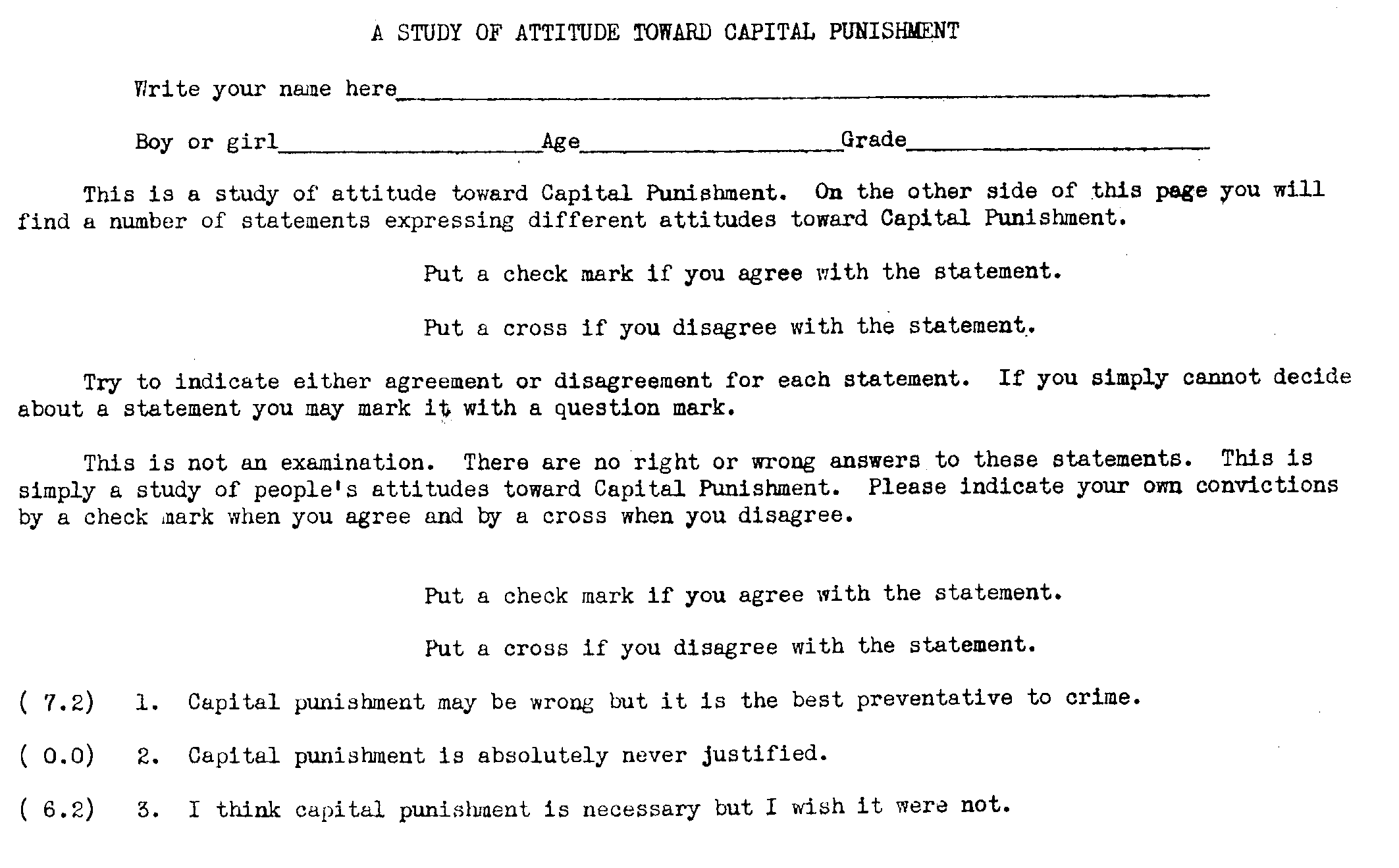
(26)
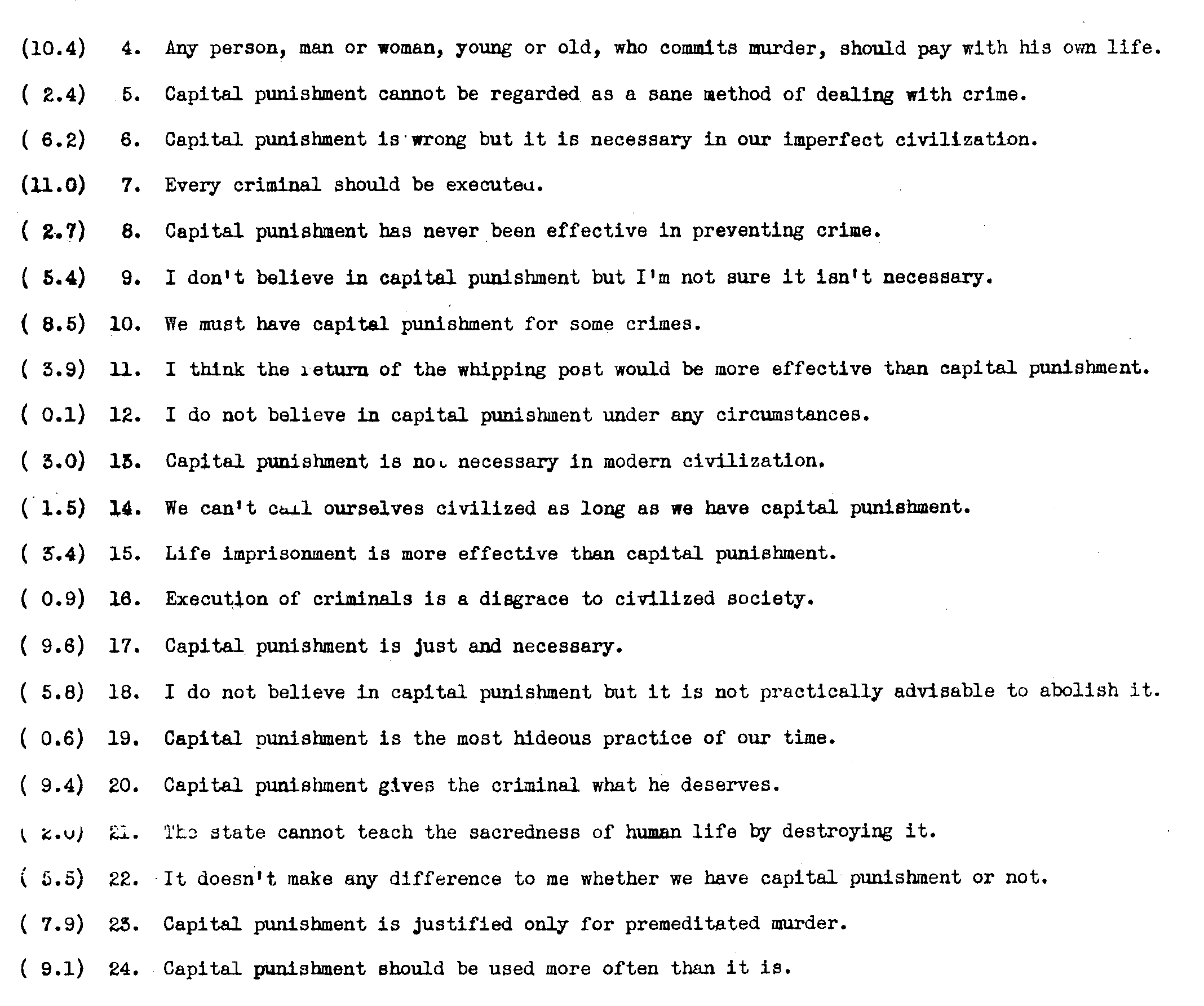
The two frequency distributions, representing the attitudes of the children before and after seeing the film are given in Figure 8. The mean score of the group before was 6.46; after 6.41, a change of .05 scale step with a P.E.D of .037. The ratio of the difference to the P.E.D is 1.35 which, although it is not a significant difference, is in the expected direction.
( 27)
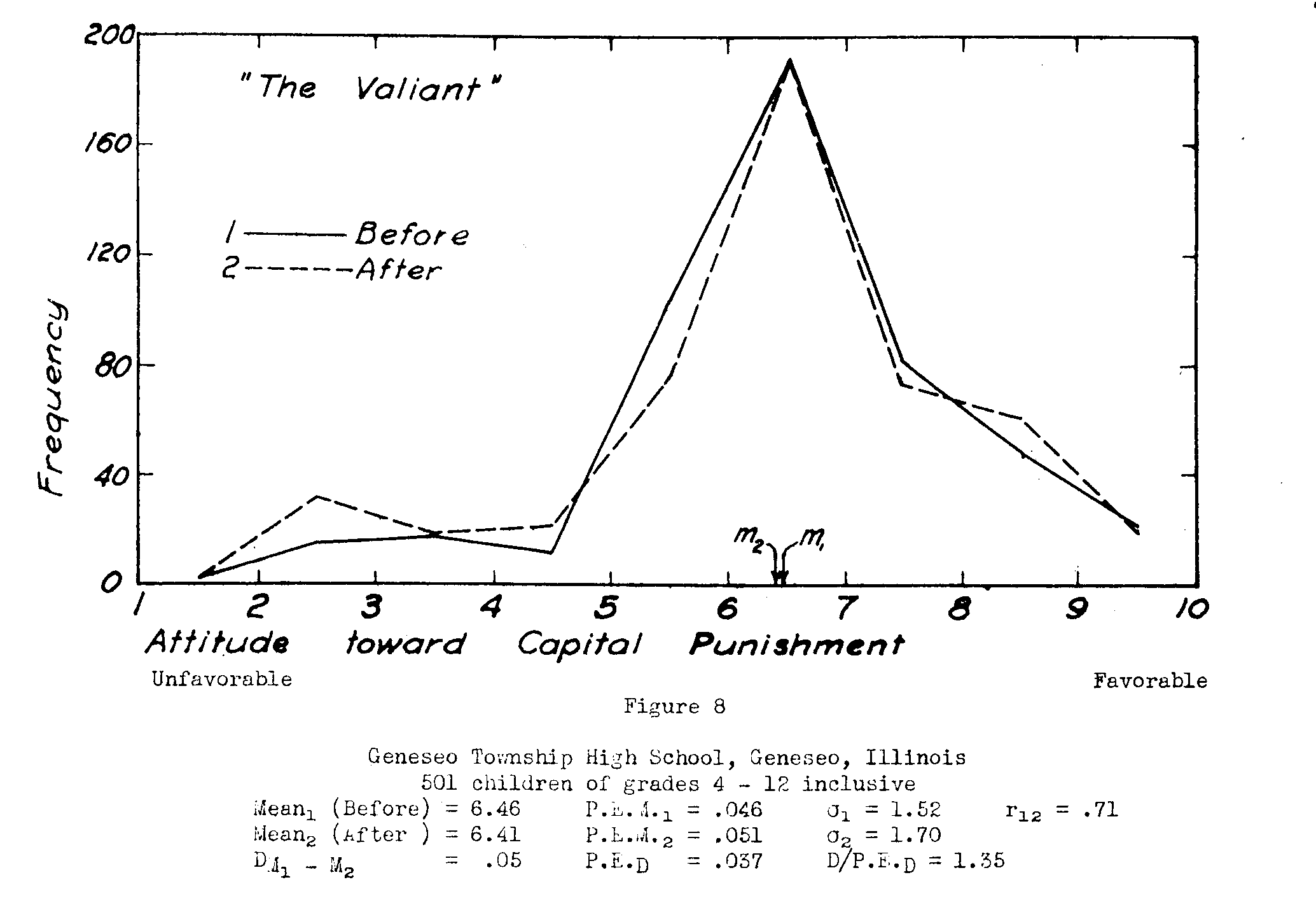
We conclude that, although the film "The Valiant" showed a slight effect on the children's attitudes, making them less favorable to capital punishment, the effect is not statistically significant. Neither the mean attitude scores nor the amount of change showed any consistent variation from the younger to the older age groups.
Mr. H. C. Storm, Superintendent of Schools at Batavia, Illinois, helped us arrange an experiment in his school to study the effect of the film "Journey's End" on the children's attitudes toward war. Batavia is a town of about 5000 population. 301 children of grades 7 to 12 took part in the experiment.
Α scale of attitude toward war was given in the school on January 30, 1951. The motion picture "Journey's End" was shown at a special matinee performance on February 24, and the attitude scale was given again on February 25.
The scale of attitude toward war was as follows. (The scale values were not given on the experimental form.)
( 28)
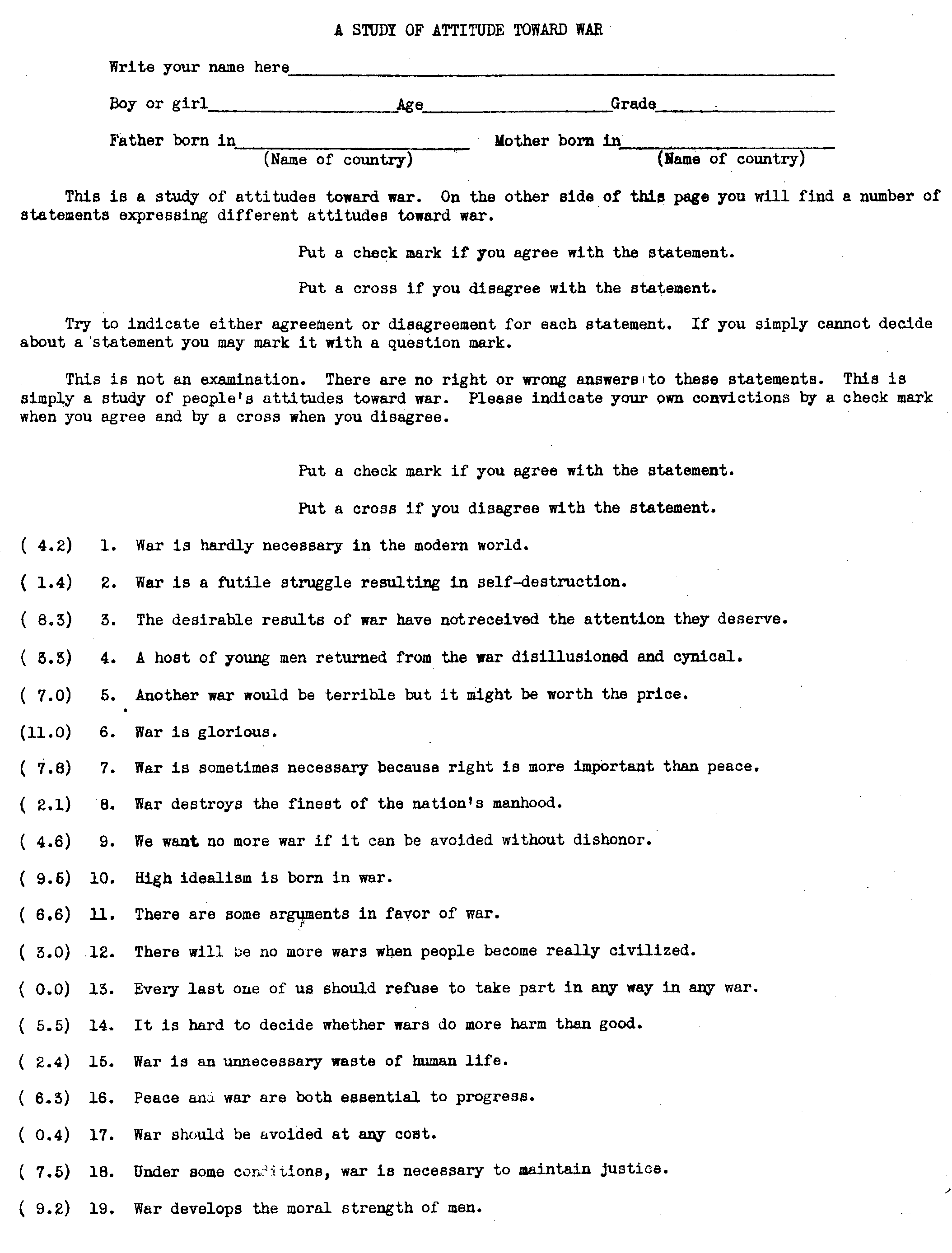
( 29)
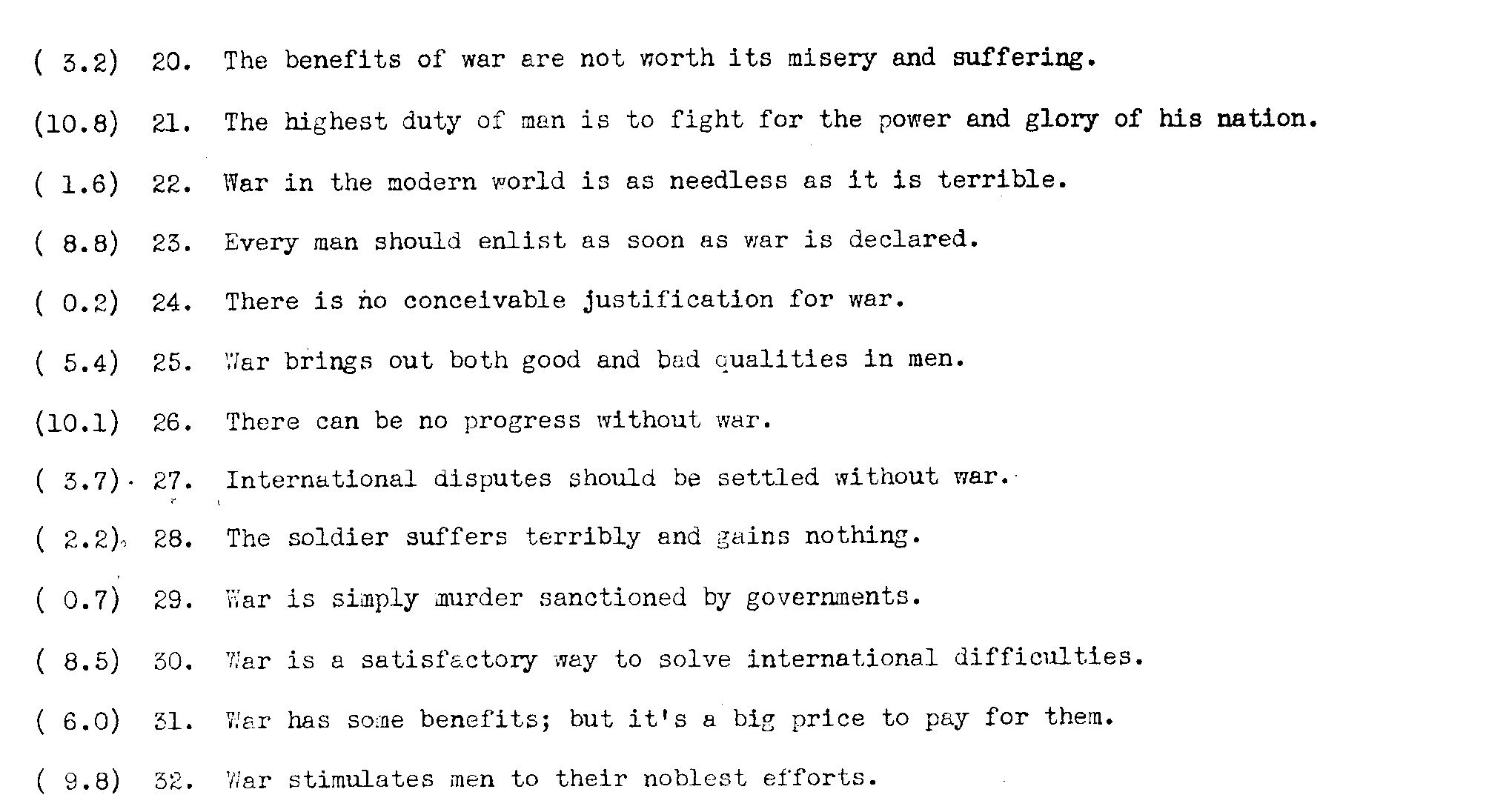
Figure 9 represents the distribution of attitude of the group before and after seeing the picture. The change in attitude is small, but in the expected direction.
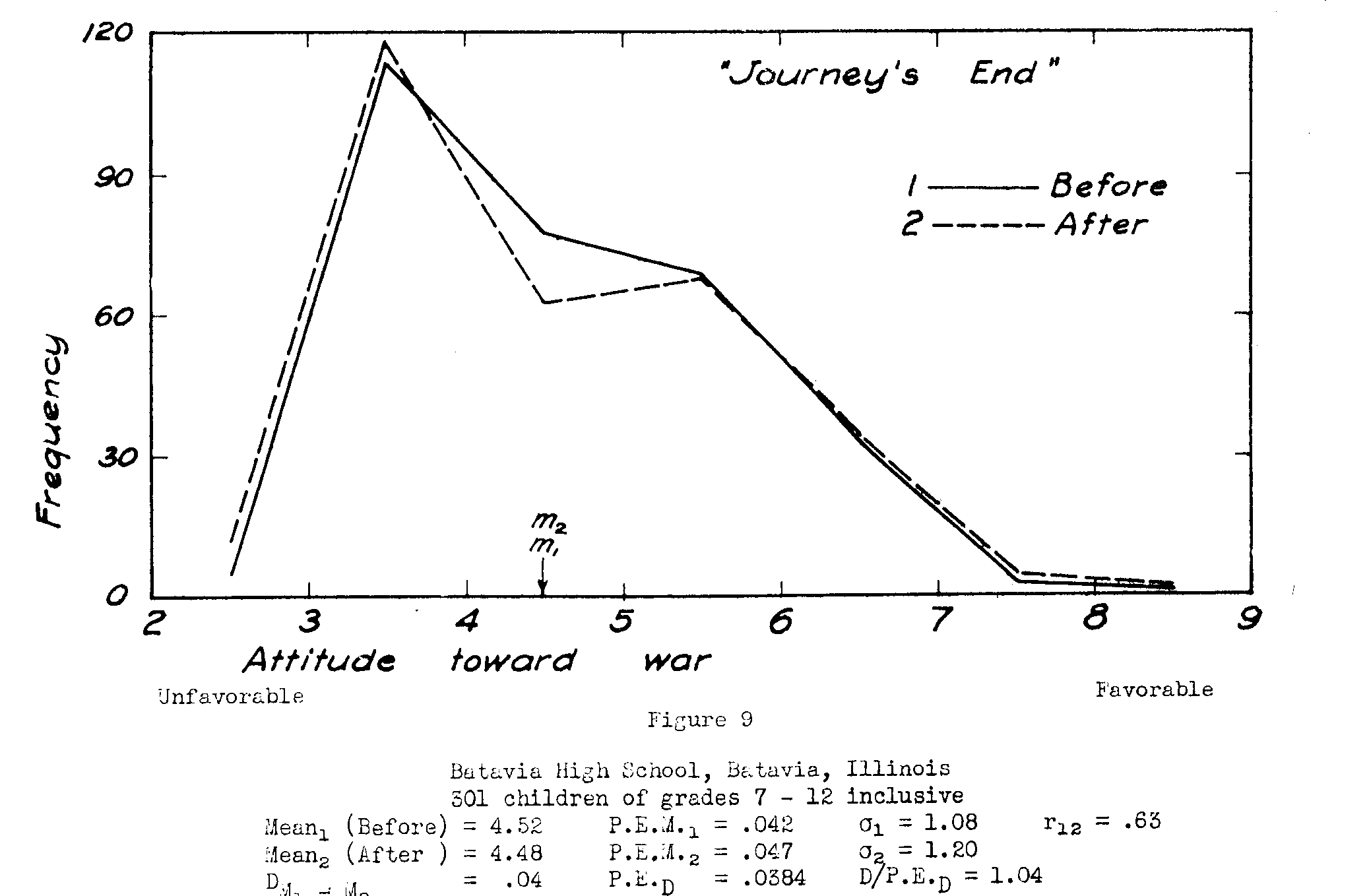
The comparison of the effect of “Journey’s End” and “All Quiet on the Western Front,” both
( 30) of which are considered outstanding pictures and powerful as anti-war propaganda, is interesting. Later in this report we present the results of an experiment using the picture "All Quiet on the Western Front". In that experiment', the change in attitude is very striking. There is nothing in the experimental set-up which might explain the difference, and we consider it probable that the picture "Journey's End" is too sophisticated in its propaganda for high school children. It is possible that the two pictures might have more nearly equal effects on the attitudes of adults.
The motion picture "All Quiet on the Western Front" was shown to 214 high school students in Paxton, Illinois (population, 3000) to study the effect of the film on attitude toward war. Mr. John J. Swinney, Principal of the Paxton Community High School, arranged to have the scale of attitude toward war given in his school on March 16, 1931. The picture was shown in the local theatre on March 25, and the attitude scale was given in the school on March 26.
The attitude scale used in this experiment was the same as the scale used in the experiment at Batavia, Illinois.
In figure 10 we nave plotted the frequency distributions of the scores on attitude toward war before and after seeing the film. The mean attitude of the group before was 4.33; after seeing the picture it was 3.65, a change of .68 of a scale step. The change is in the direction of pacifism. The P.E.D is .0454, the ratio of the difference to the P.Ε.D is 14.98.
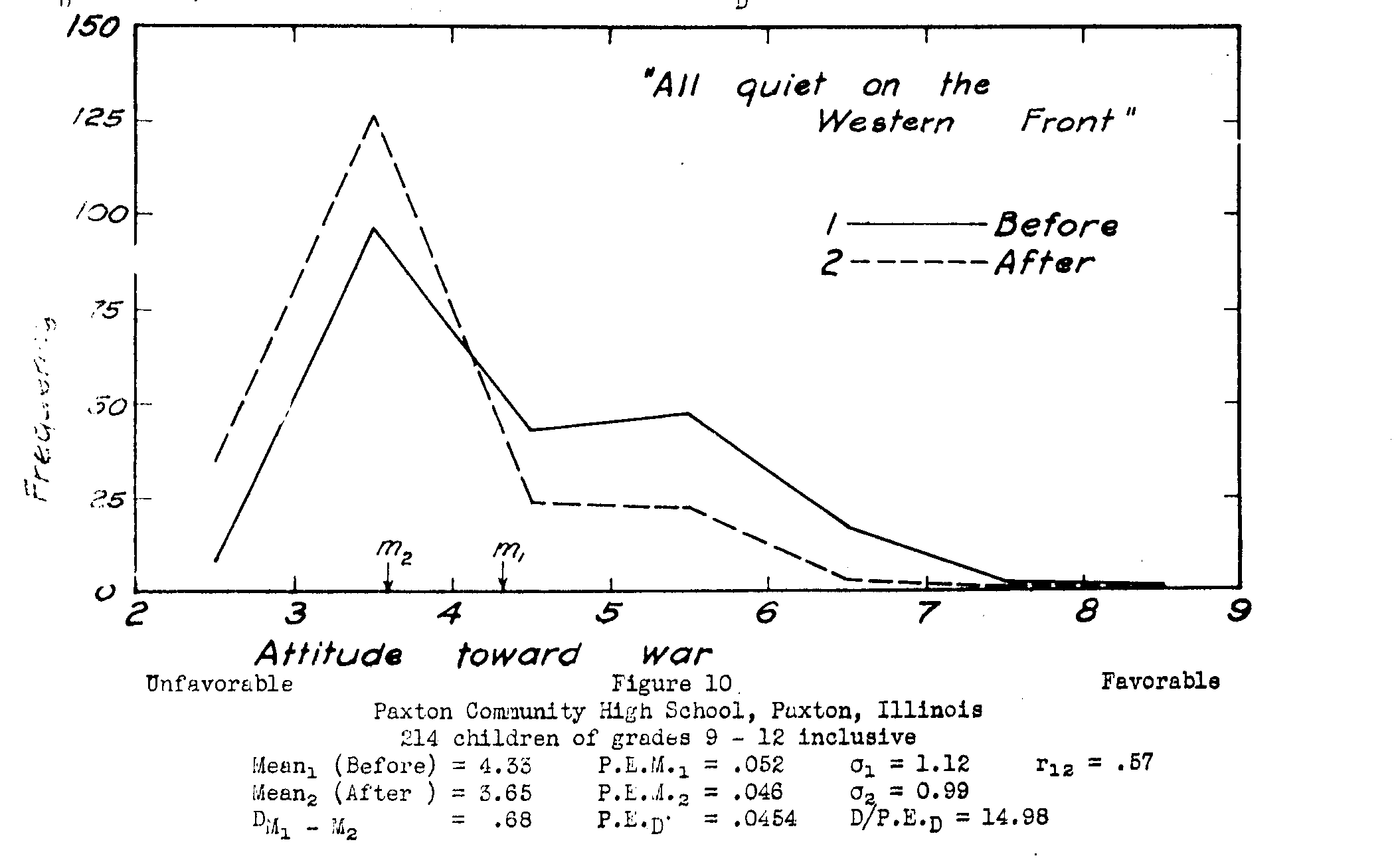
( 31)
The change in the children's attitude toward war as a result of seeing the film "All Quiet on the Western Front" is very evident.
The motion picture "The Criminal Code" was used in experiments at Watseka (population 3,100) and Galesburg, Illinois (population 28,800). In Watseka the experimental group included 276 children of grades 7 to 12 inclusive; the Galesburg group included 246 students of Knox College. We wished to study the difference in the effect of this picture on high school and college students.
Mr. E. W. Powers, Principal of the Watseka Community High School, suggested that the scale of attitude toward the punishment of criminals which was used in the experiment should be simplified. He felt that some of the statements in the original form might not be easily understood by the group, especially the seventh and eighth grades. Consequently, the statements were given in the following form:
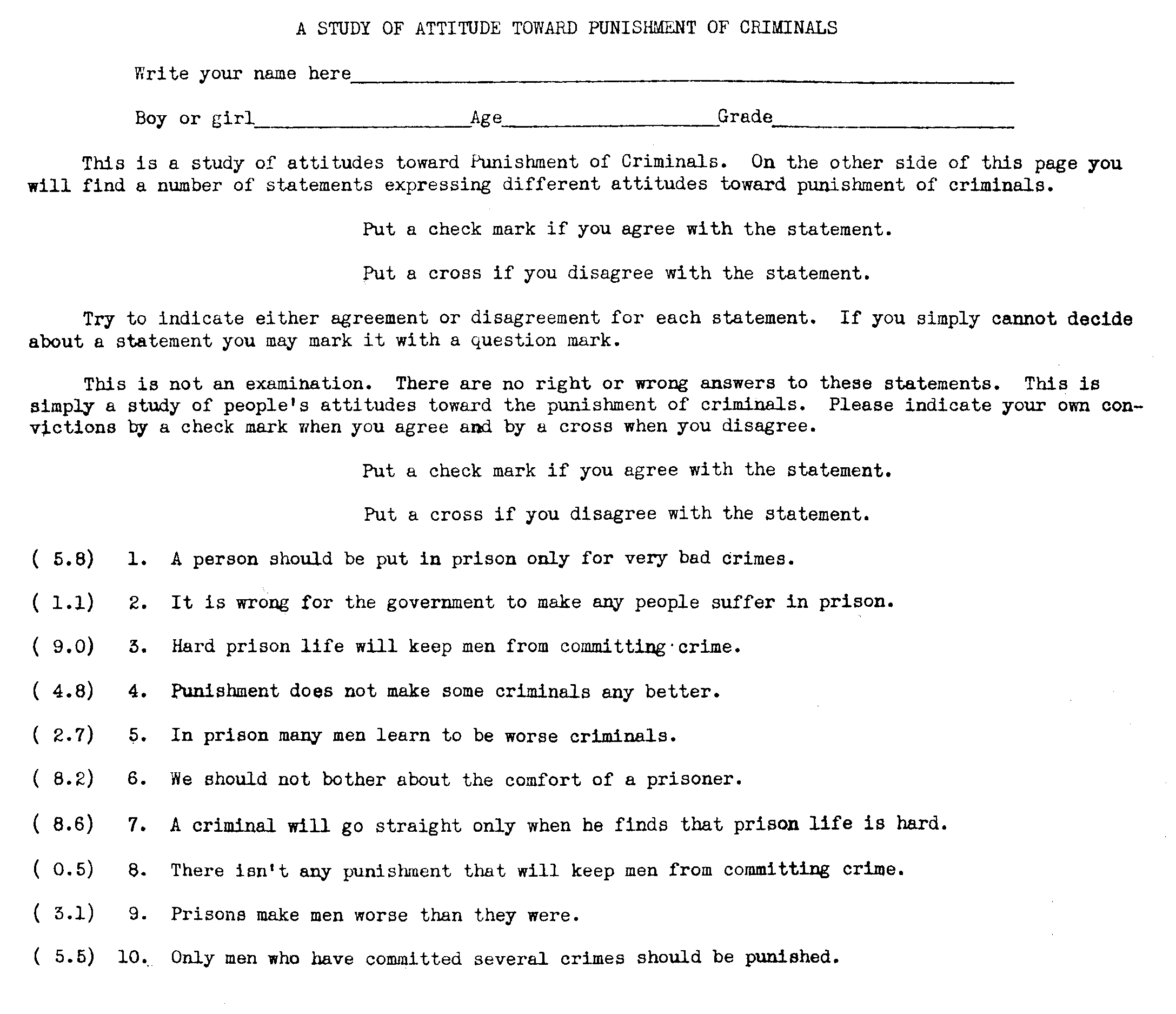
( 32)
insert table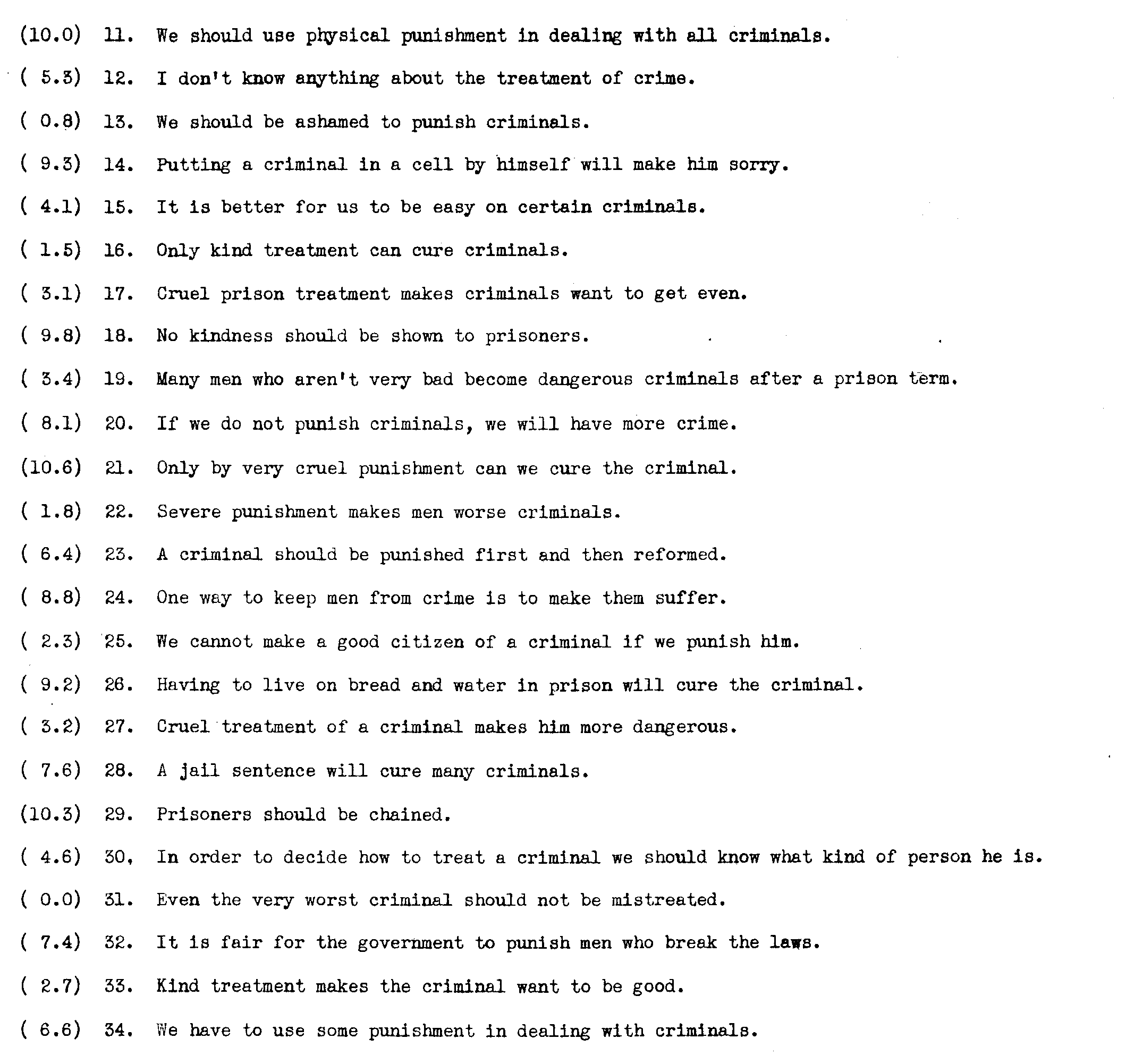
February 19, 1931 was the date of the first application of the scale, the motion picture 'Was shown in a local theatre on the afternoon of March 5, and the attitude scale was given in the school the second time on March 4.
The two frequency distributions, representing the attitudes of the group before and after they saw the film are given in Figure 11.
The mean score before was 5.30; after 4.80, a change of .50 of a scale step. The difference is 11.7 x P.E.D.
( 33)
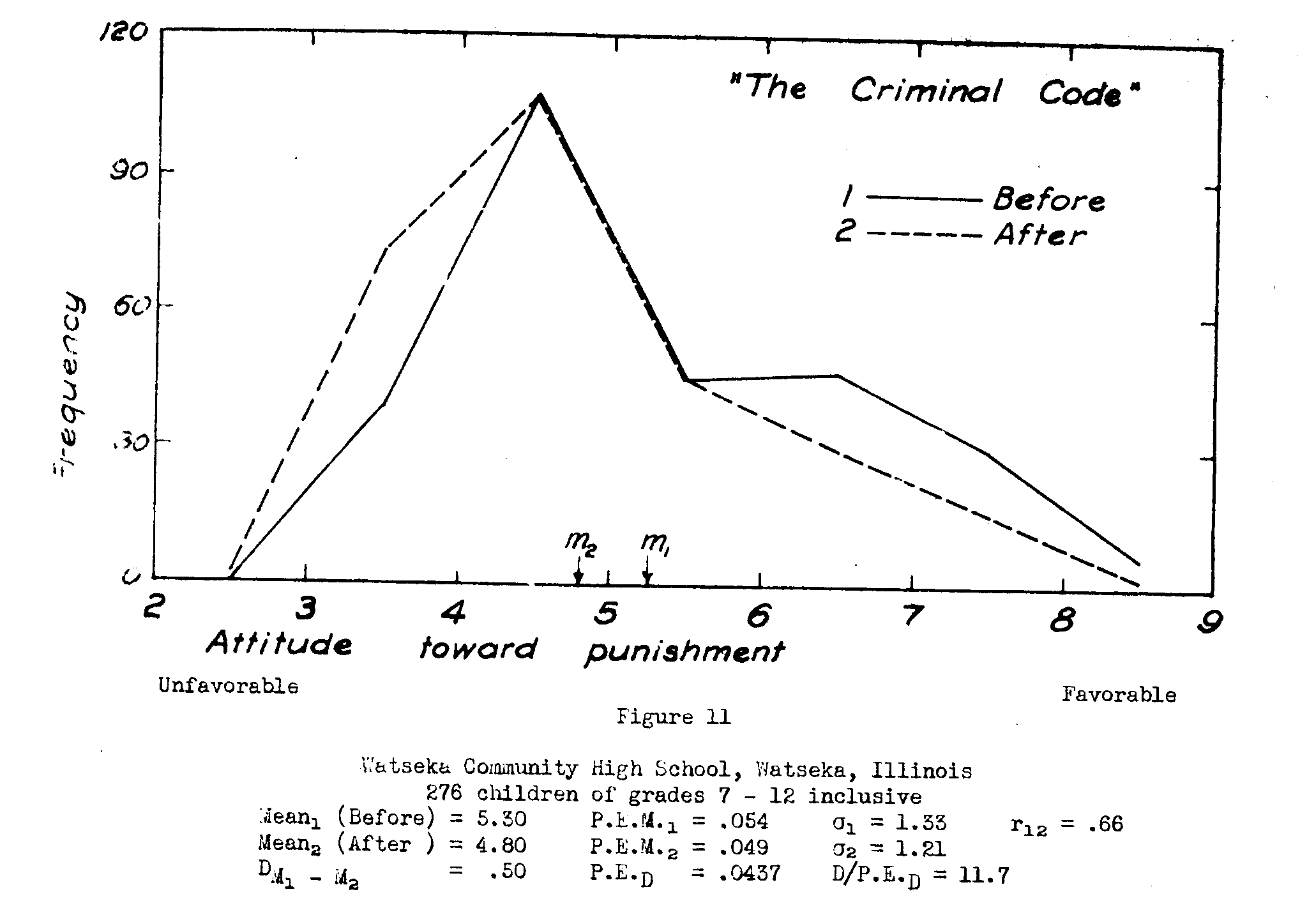
The experiment conducted at Knox College, Galesburg, with the assistance of Mr. Rutledge T. Wiltbank, used the same scale of attitude toward punishment of criminals that was used in Watseka, but in its original form. It is given below.
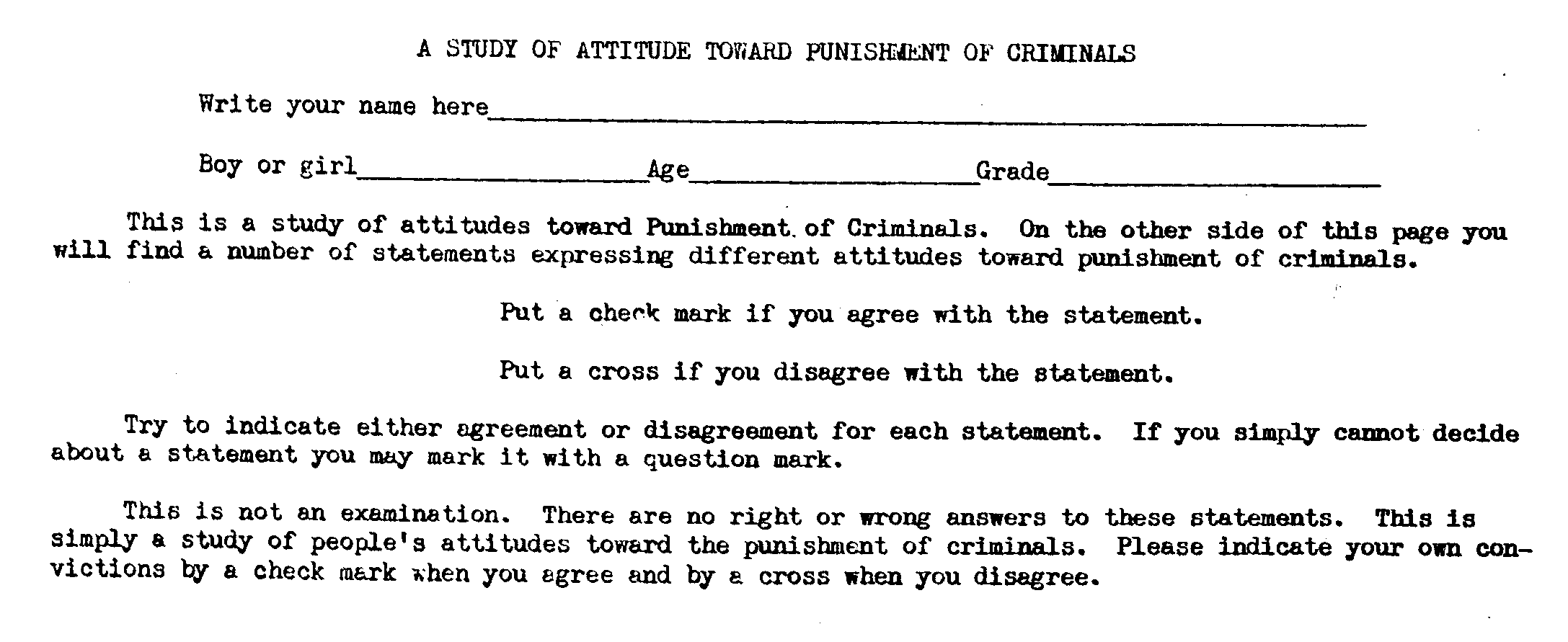
( 34)
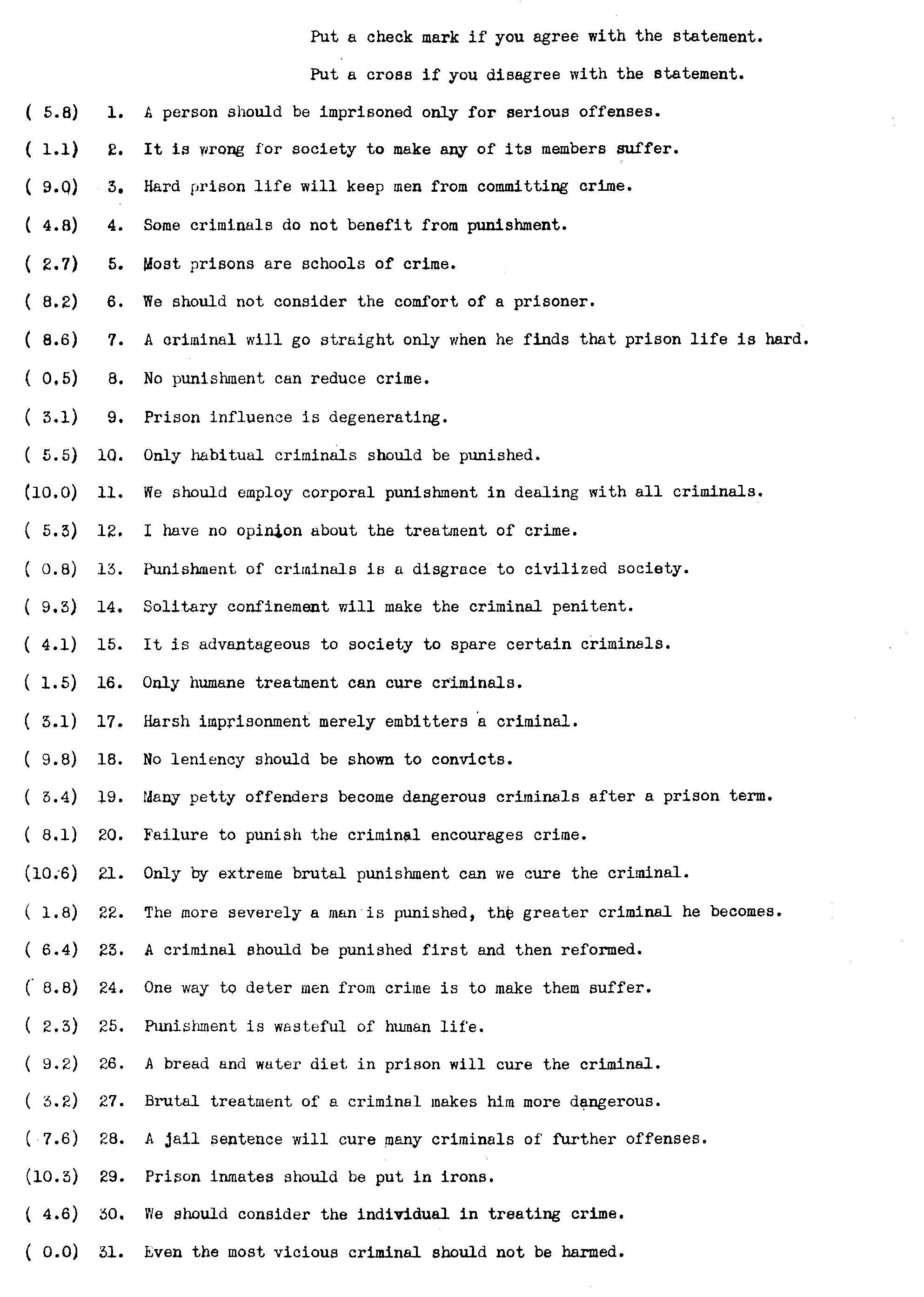
( 35)

The attitude scale was given to the college students on February 16, 1931. "The Criminal Code" was shown at a special performance in the West Theatre on Saturday morning, February 28, and the attitude scale was given in the college the following Monday, March 1st.
The two distributions, before and after, are given in figure 12. The mean attitude of the group before seeing the film was 4.95; after, 4.46, a change of .49 scale step with a P.E.D of .04, giving a ratio of the difference to the P.E.D of 12.2
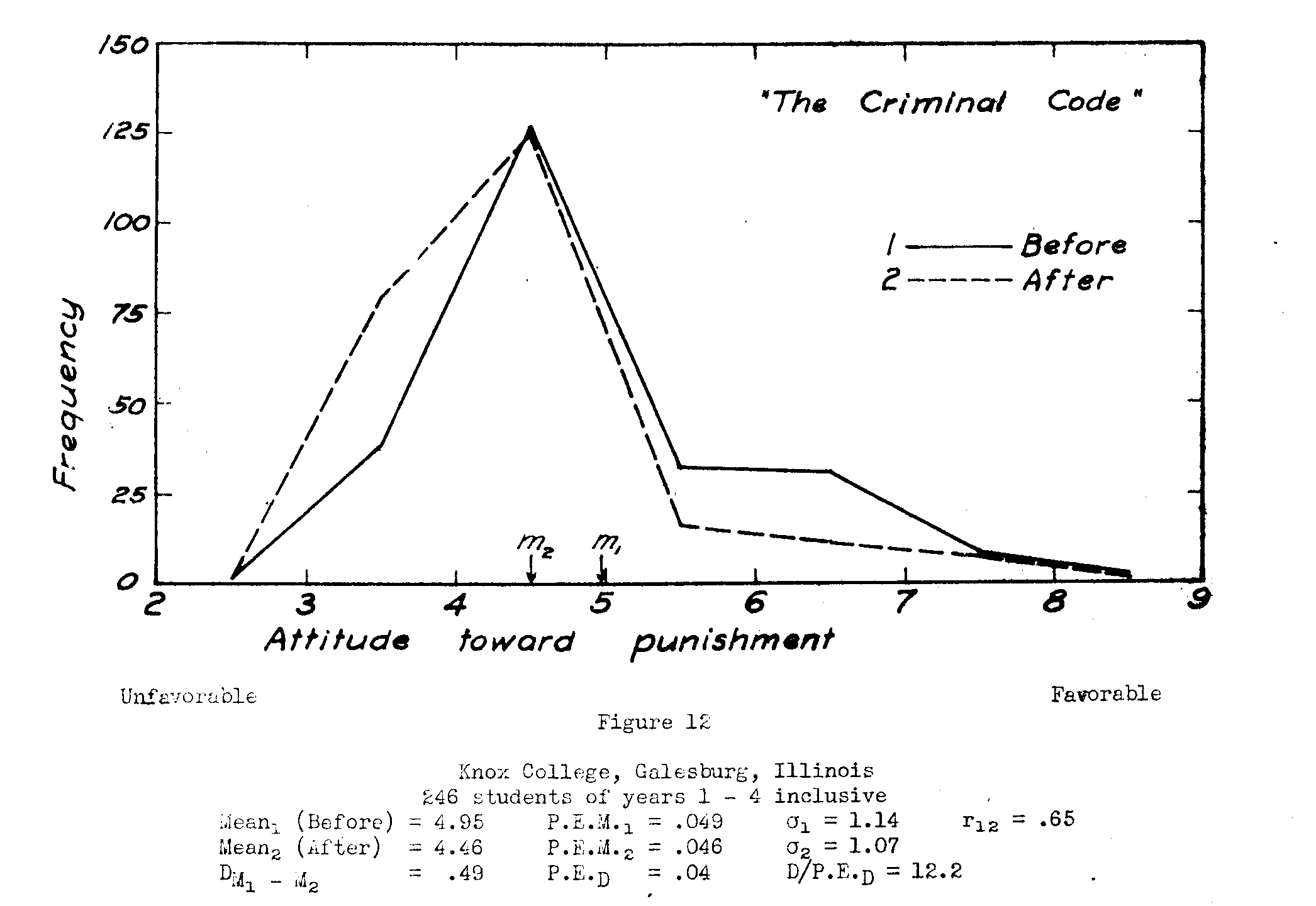
The change in attitude for the high school group (.50) is comparable to that for the college group (.49). The mean attitude of the high school group (5.30) before the motion picture, was, however, considerably higher than that of the college group (4.95). The effect of the motion picture on the college group, although slightly smaller than the effect on the high school group, may be equally or more significant. The college group was less in favor of punishment of criminals than the high school group was before the film was shown and changed almost, as. much. In other words, a change in
( 36) the direction of leniency from a position which was originally more in favor of leniency may be more significant than a slightly larger change from an original position which was more in favor of punishment.
Figure 13 gives the two frequency distributions before and after seeing "The
Criminal Code" for the combined groups of Galesburg and Watseka. The statistical
facts about the two distributions are given below.

The film "Alibi" tells the story of a police sergeant's daughter who sympathizes with crooks and believes that they are persecuted by the police. The picture finally shows the girl convinced that the gangster has not reformed, and she is disillusioned about persecuted crooks. This picture has been barred by the censor board of a large city because its effect was considered anti-social. We were interested in finding out whether the film had a measurable effect on the attitudes of high school children toward the treatment of criminals.
The scale of attitude toward punishment of criminals was given to 352 students of grades 7 to 12 inclusive in the Aledo, Illinois, Public Schools. Aledo has a population of 2,200. The experiment
( 37) was carried on with the assistance of Mr. L. C. McCarty, Superintendent of the Aledo Public Schools and Mr. R. E. Dahl, Principal of the Junior High School. The scale was given on April 27, 1931, the motion picture has shown at a local theatre on May 14, and the scale was given the second time on May 15.
Figure 14 shows the frequency distributions of attitude before and after the children saw the film. The mean attitude of the group before was 5.24; after, 5.17, a change of .07 with a P.E.D of .042, giving a ratio of the difference to the P.E,.D of 1.67. There was a slight change of attitude in the direction of leniency toward the punishment of criminals, but the change is not statistically significant.
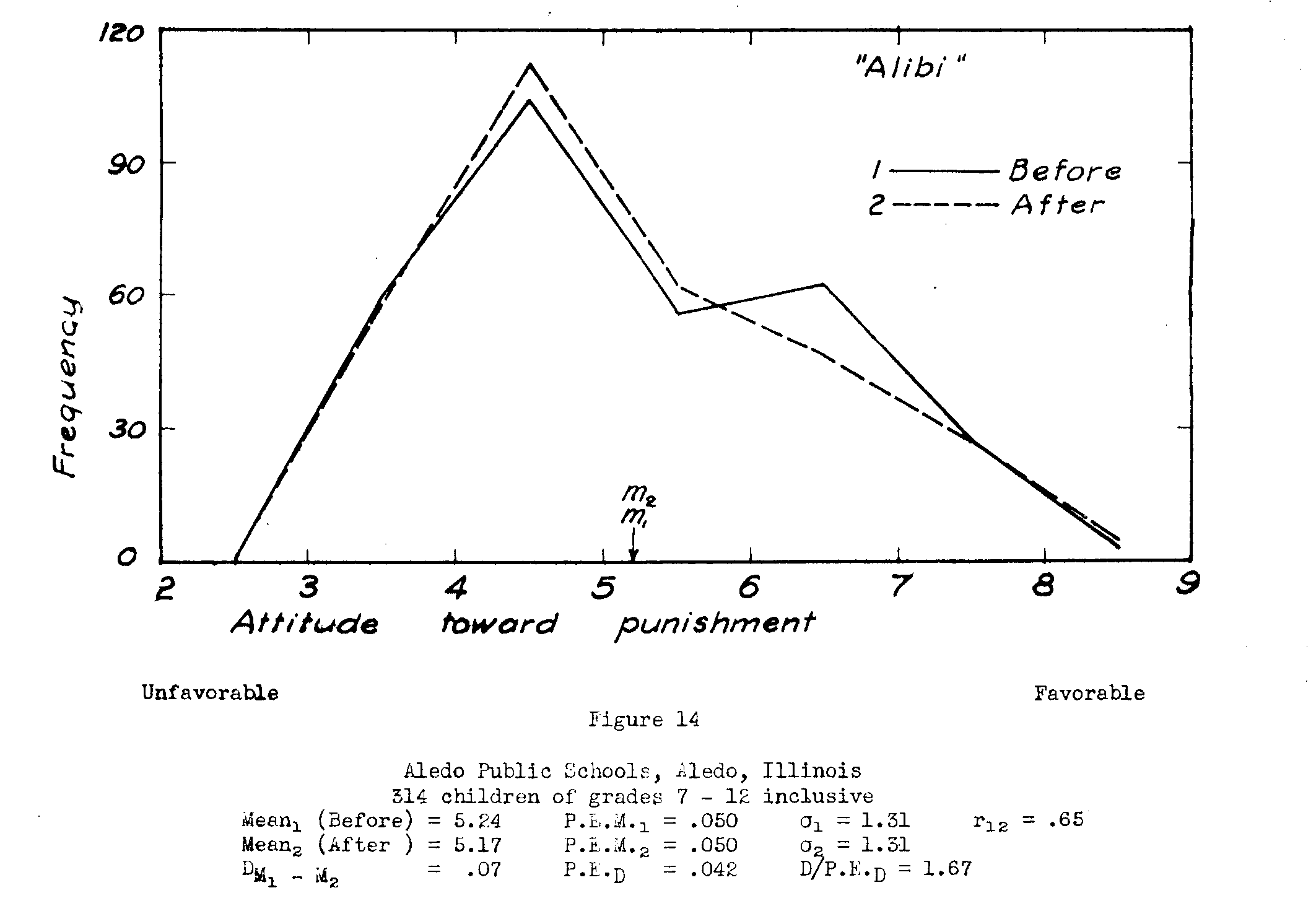 .
.
We conclude, therefore, that the film "Alibi" had no measurable effect on the attitudes of the children toward punishment of criminals.
( 38)
"The Birth of a Nation", a picture very widely known a number of years ago, was returned to the screen in 1931 with sound accompaniment. It has been considered as powerful anti-negro propaganda. We wished to study the effect of this picture on attitude toward the negro, and with the co-operation of Mr.. H. Α. Dean, Superintendent of Schools in Crystal Lake, Illinois, a scale f attitude toward the negro was given to 434 students of grades ß to 12 inclusive in his school. Crystal Lake is a town of 3,700 population, but has no negroes. Ur. Dean told us that, in all probability, very few of the children had known or even seen negroes. The mean attitude of the group on the first application of the scale of attitude toward the negro was 7.46. The range of the scale is from zero to eleven, with the higher scale values for the statements which are favorable to the negro.
The attitude scale and the scale values for each statement are given below: (The scale values were not, of course, given on the form used.)
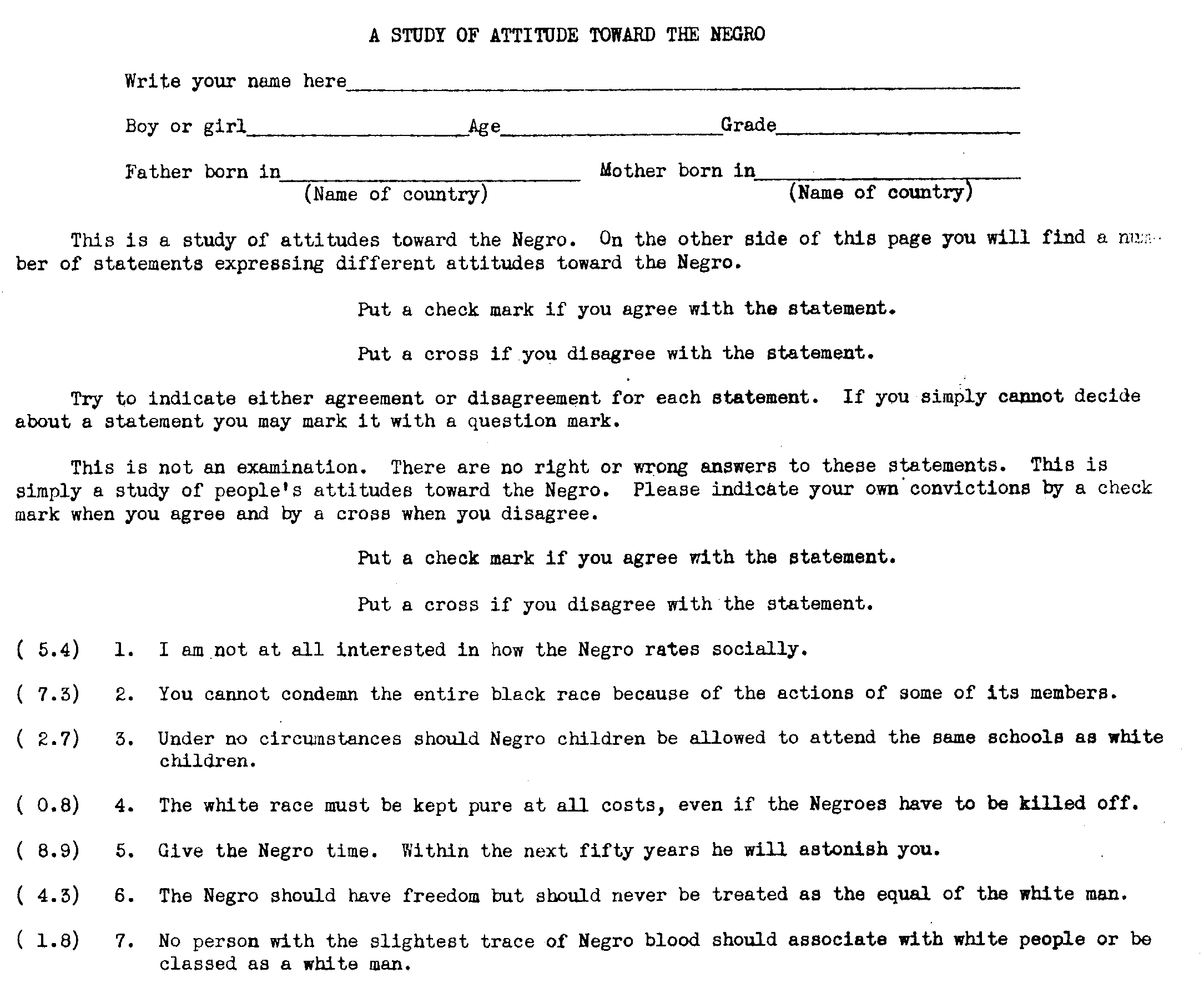
( 39)
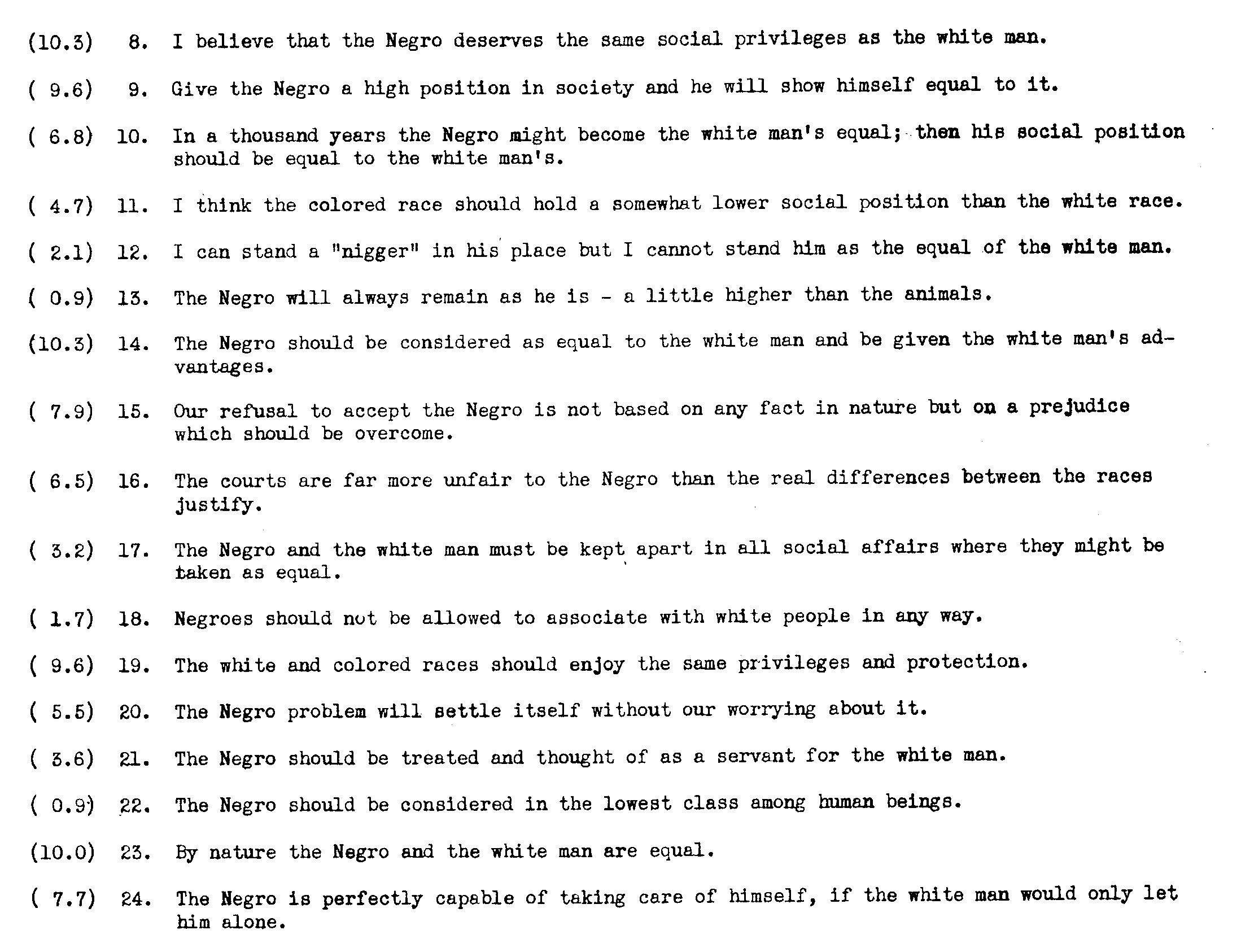
The above scale was given in the school on May 18, 1931. "The Birth of a Nation" was shown at a local theatre on the afternoon of May 25 at a special performance for the experimental group. The attitude scale was given again in the school on May 26.
The two frequency distributions, representing the attitudes of the group before and after they saw the picture are given in figure 15. The change is very striking, the average change for the group of 434 children is 1.48 scale steps. The difference is 25.5 x Ρ.Ε.D. This is the largest effect found in any of the experiments we conducted.
( 40)
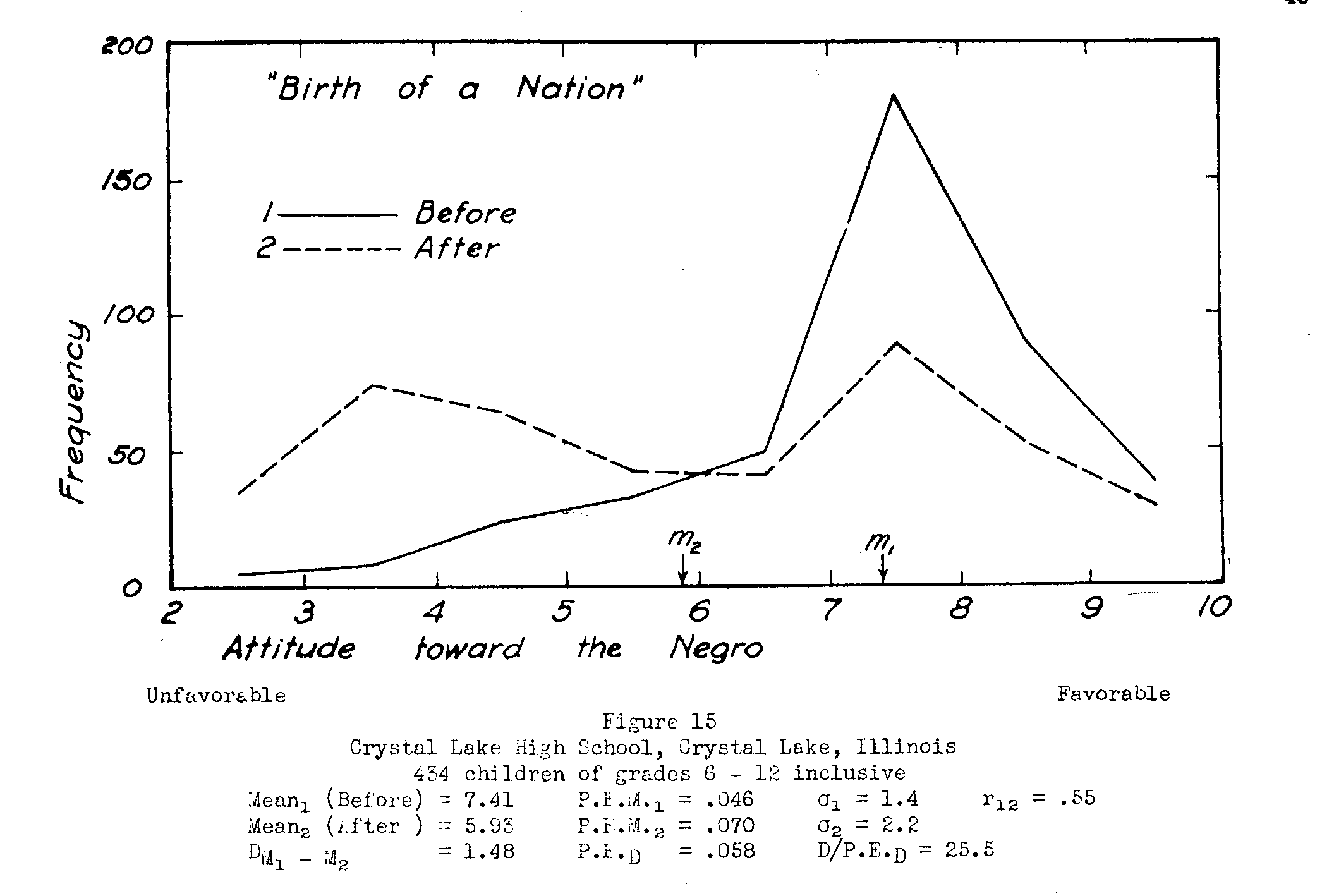
The conclusion that the motion picture "The Birth of a Nation" had the effect
of making the children less favorable to the negro is undoubtedly justified. Α
later section of this report will give the persistence of the effect measured.
It was interesting to find that the change in attitude was so marked and that,
after an interval, the attitude of the group was still definitely less favorable
to the negro than before the film was seen.